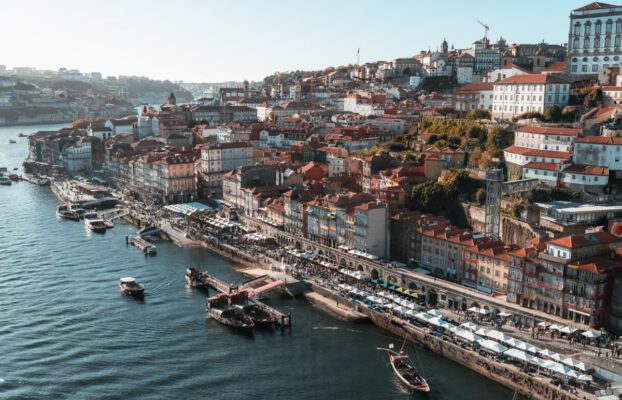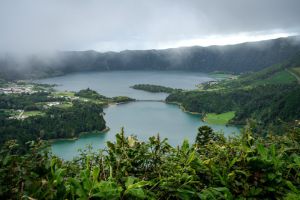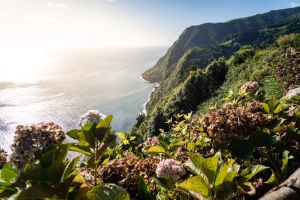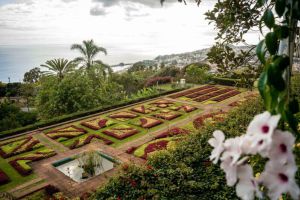Porto is an enchantingly romantic port city in the north of Portugal and lies on the banks of the Douro River, which is spanned by majestic bridges. The city is particularly famous for its historic old town with its typical red-tiled roofs. This is also a UNESCO World Heritage Site. Porto is also the namesake of the legendary port wine, which is actually produced in neighboring Vila Nova de Gaia.
The best thing is that many of Porto’s sights are very close to each other, which makes Porto the perfect destination for a city trip. In this article, I will give you tips on Porto sights, which tours are worthwhile and which highlights you should not miss when visiting.
The inhabitants of Portugal’s second largest city are considered to be very enterprising, as Porto has always been a center of trade. Sweet port wine, for example, is exported all over the world from here. However, since the beginning of its existence, the city has repeatedly had to defend itself against the imposition of constraints and attacks. And it has done so very successfully, which is why Porto is also known as the “invincible city”.
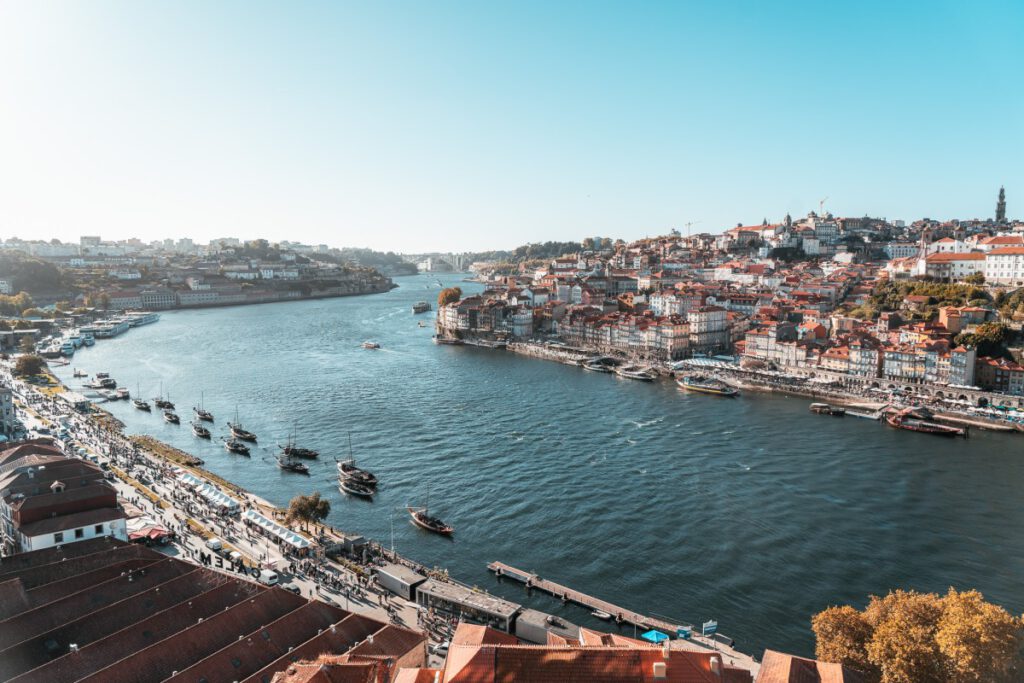
The many blue azulejos are also very typical of Porto – these are painted tiles that are mainly used on church façades. This gives Porto’s many historic churches a very special flair. But you can also find these azulejos in all colors and variations on normal house walls.
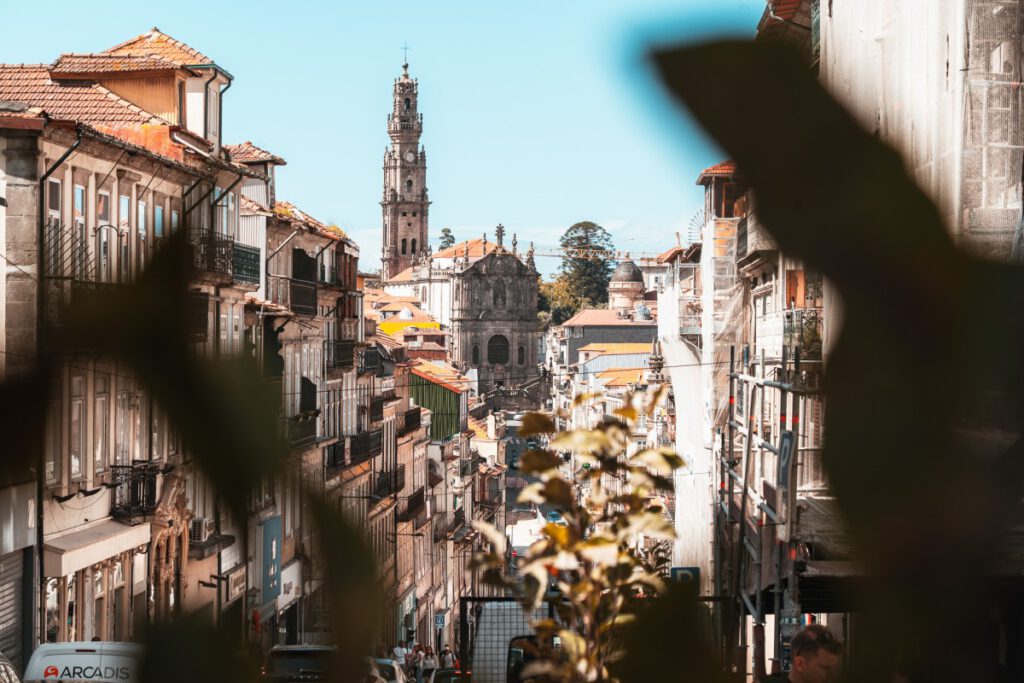
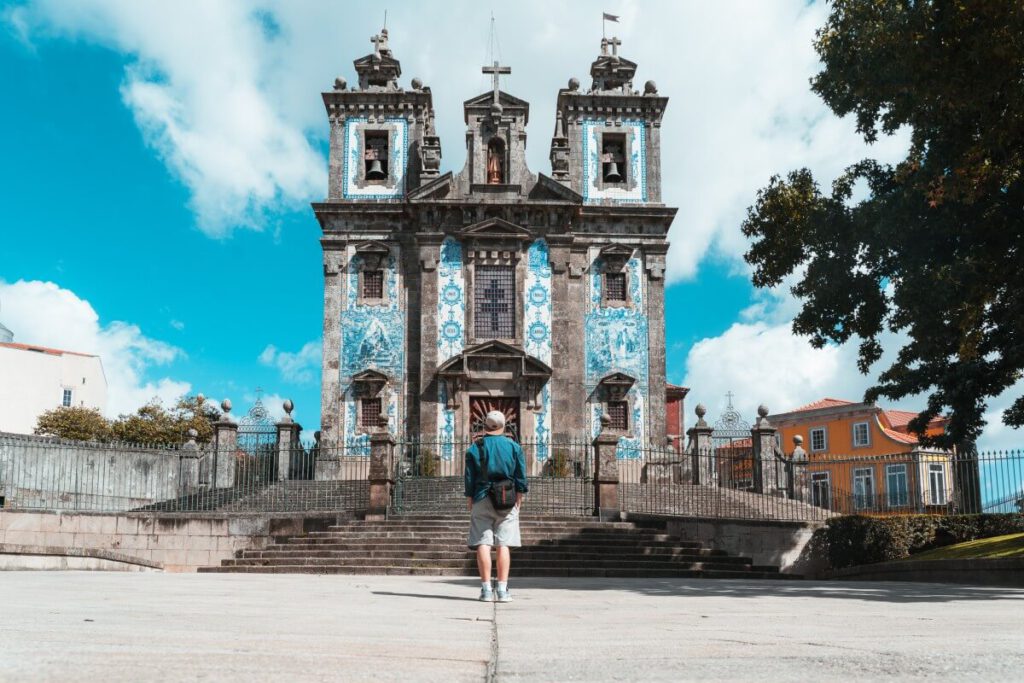
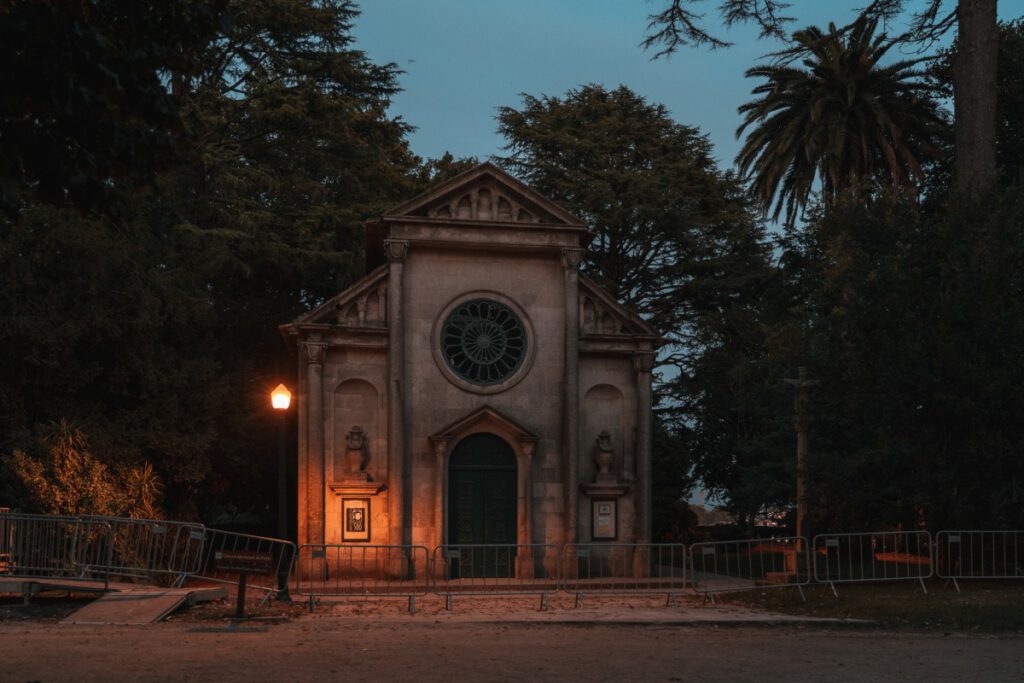
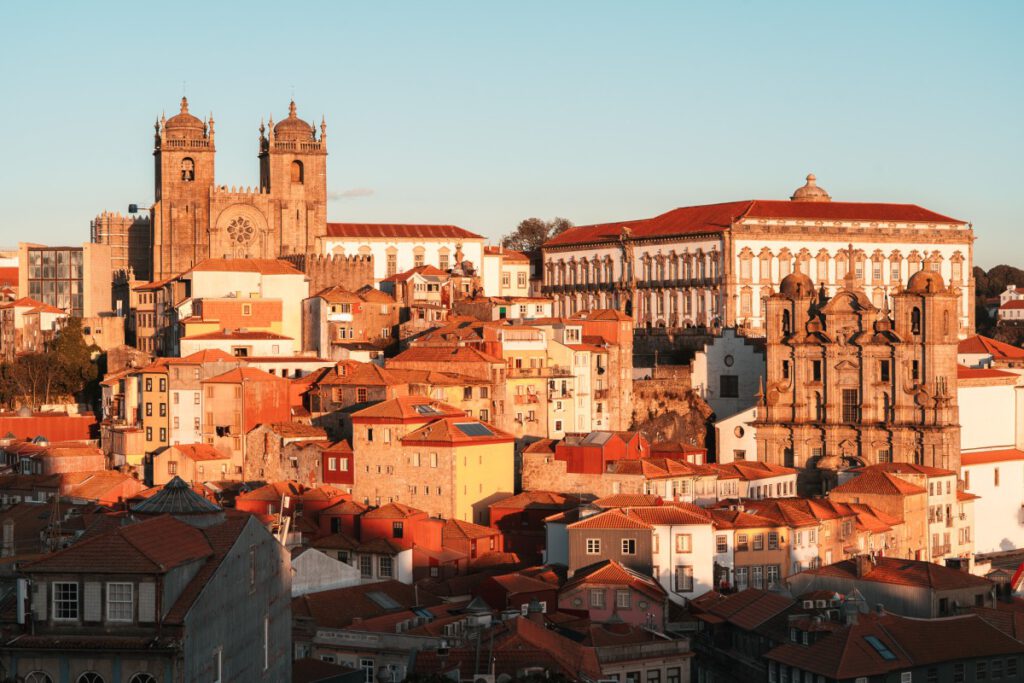
All the following Porto tips can also be found here on the map:
If you want to experience as many highlights as possible in a short space of time, then a guided tour of Porto is not such a bad idea. There are many different options:
- City tour by hop-on hop-off bus tour
- City Highlights 3-hour guided electric bike tour
- Guided tour by tuk-tuk and Douro river cruise
💡 Tip: Save money with the Porto Card
With the Porto Card, you can save money at many museums, sights, theaters and concerts, when shopping, in cafés and restaurants. You can also use it for unlimited travel on the metro (subway) and buses.
- 🚆 Simply hop on the metro (subway) and city buses and stop thinking about buying tickets.
- 🎫 Free entry to 5 museums + discounts at Clérigos, Palácio da Bolsa and many more.
- 📱 Special offers in restaurants, stores and other places.
- 📱 Bookable for 1 to 4 days.
Show more discounts & benefits
- 5 museums free of charge – Casa do Infante, Casa-Museu Marta Ortigão Sampaio, Museu Romântico, Museu do Papel-Moeda, Reservatório
- 50% discount on admission to 12 museums, monuments and experiences
- 50% discount in a port wine cellar
- Up to 50% on selected museums & attractions
- and much more…
It’s that simple: Select the date of the first day and the number of days. You must then collect the card on site, either at the Sé Posto de Turismo, in Calçada D. Pedro Pitões, nº15, daily from 9 am to 6 pm or at the Interactive Tourism Office at the airport, on floor 0 (public arrivals area), daily from 8 am to 6:30 pm.
The best places to stay & hotels in Porto
Porto not only has many great hotels, but also plenty of airbnbs in the middle of the city. Of course, it’s best to find accommodation in the middle of the old town. However, these are usually a bit more expensive, which is why I always look for accommodation on the outskirts of the city center. They are still close enough to walk to.
My price-performance recommendation for Porto is the 4-star Hotel Exe Essenzia Porto. It has a cozy, modern interior with an elegant Japanese look, large rooms and modern bathrooms. The breakfast is very varied and delicious and you can reach the first sights of the old town in 15 minutes on foot.
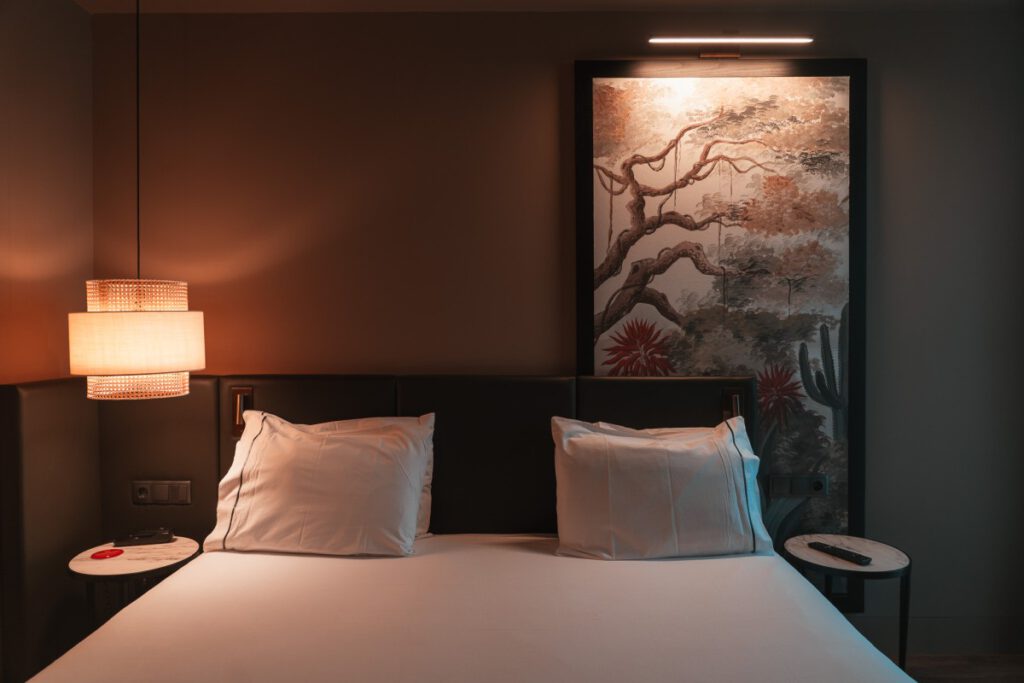
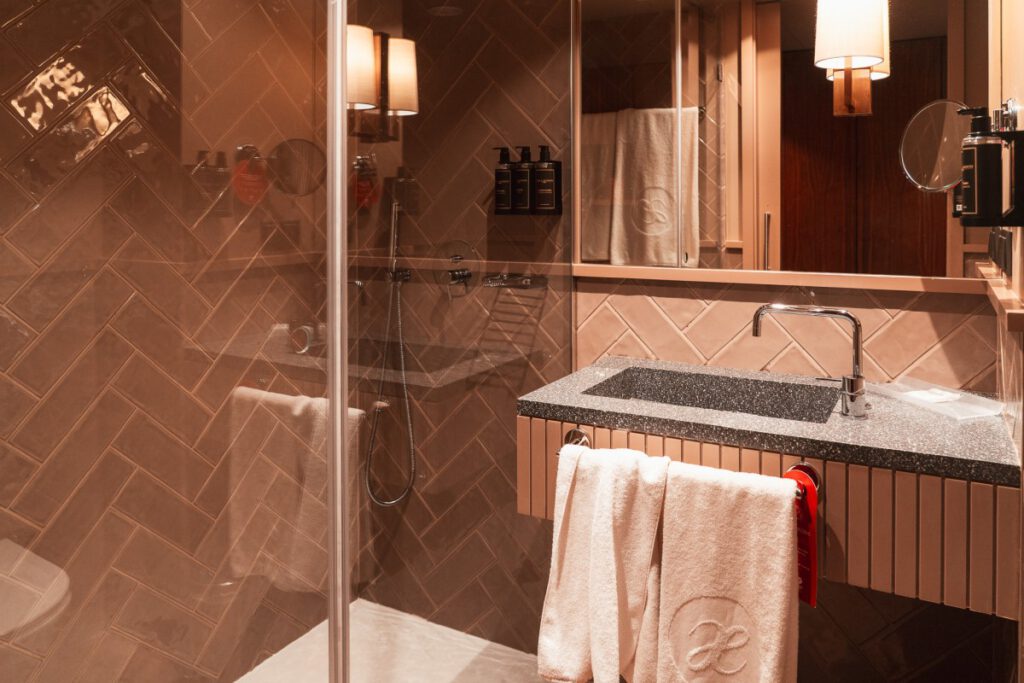
The 5-star Torel Palace Porto Hotel, which is located in a historic building dating back to 1861, is also really great. It has an outdoor pool, a restaurant and a bar and is just 600 m from Sao Bento metro station. What makes it special: Each room and suite pays homage to Portugal’s famous poets and thinkers.
Best time and duration to travel to Porto?
You can actually travel to Porto at any time. The main travel season is of course summer. Porto is quite crowded then, but there is also plenty of action. For example, the Festa de São João – Porto’s city festival – takes place at the end of June.
In spring – around March and April – the weather here is much nicer than in more northern regions of Europe and the masses of tourists have not yet arrived.
In the fall, around September, it gets a little cooler again, but it is still pleasant and not unusual to go swimming in the sea.
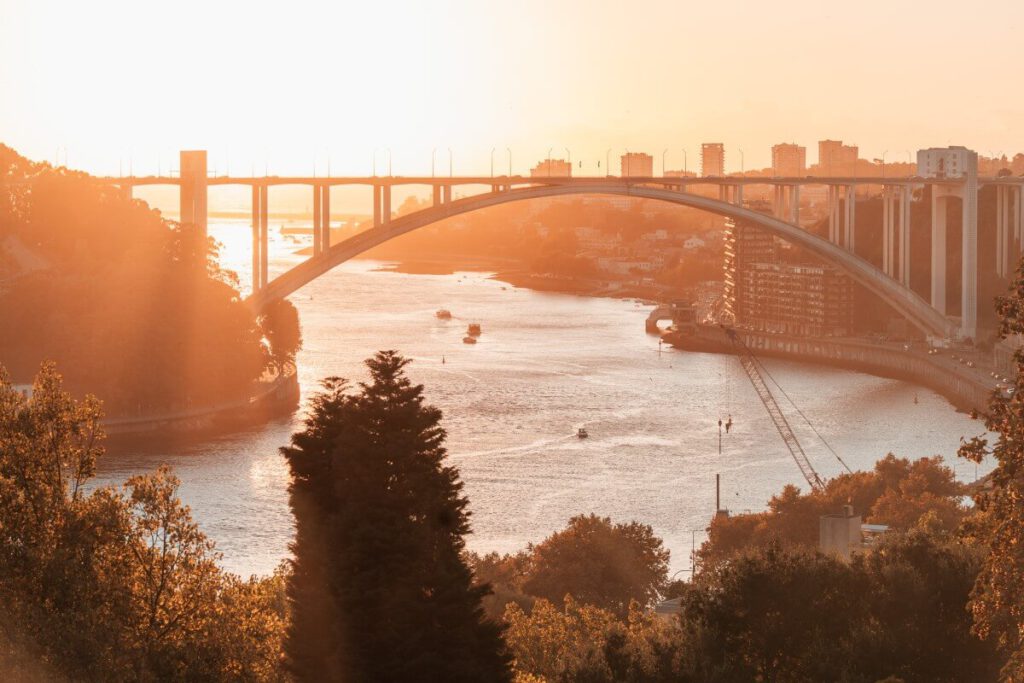
There are fewer tourists in the country before and after the main tourist season, which means you can visit the city in a more relaxed way and, in my opinion, this is the best time to visit.
In winter it is not as warm in Porto as in the south of Portugal, e.g. in the Algarve – but still in the 2-digit range and therefore pleasant enough.
How long to stay in Porto?
Porto’s old town is quite compact. But there really is a lot to see here and you often have to walk up and down from one sight to the next. That’s why just one day is not enough in my opinion. I recommend spending at least 2 full days in Porto, which is usually 3 nights. You should be able to see all the sights in this article in 2 days. If you add another day, you’ll have even more time for insider tips and cool activities.
1. Ribeira – Porto’s historic old town district right on the waterfront
One of the most beautiful parts of Porto is the picturesque Ribeira with its cobbled streets and colorful facades on the banks of the Douro. This part is a particularly well-known part of the historic old town and is dotted with old buildings, Portuguese restaurants and cafés.
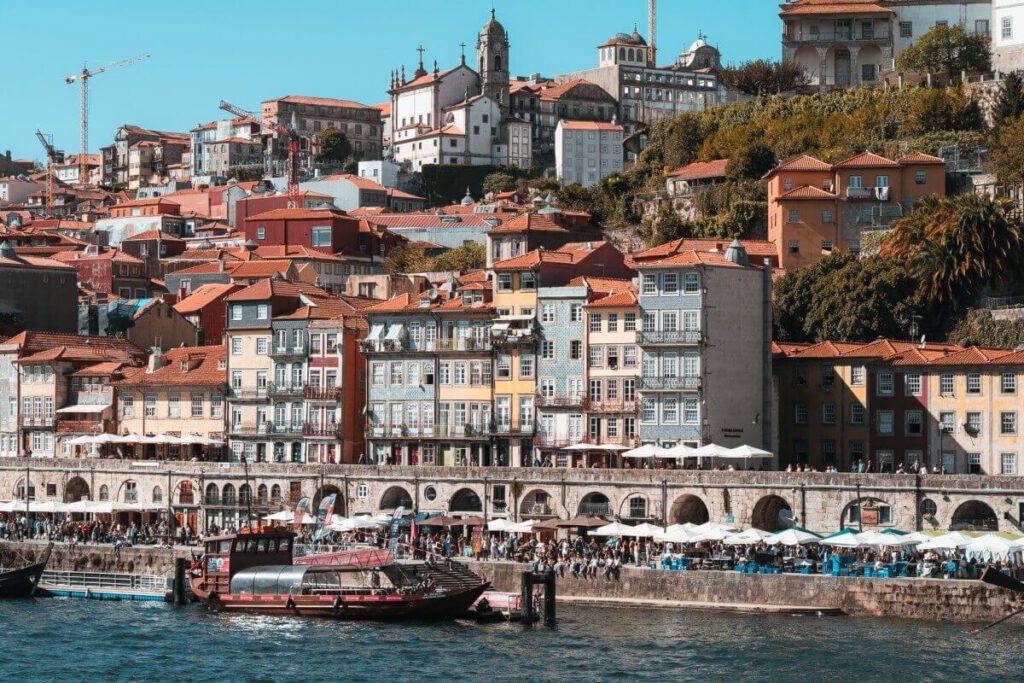
There is always a lot going on here in the evenings and during the day. Musicians play their songs for the tourists, boats set off on tours along the Douro and traders try to sell their souvenirs.
It is so beautiful there, and also in the rest of the old town, that the old town of Porto was even added to the UNESCO World Heritage List in 1996.
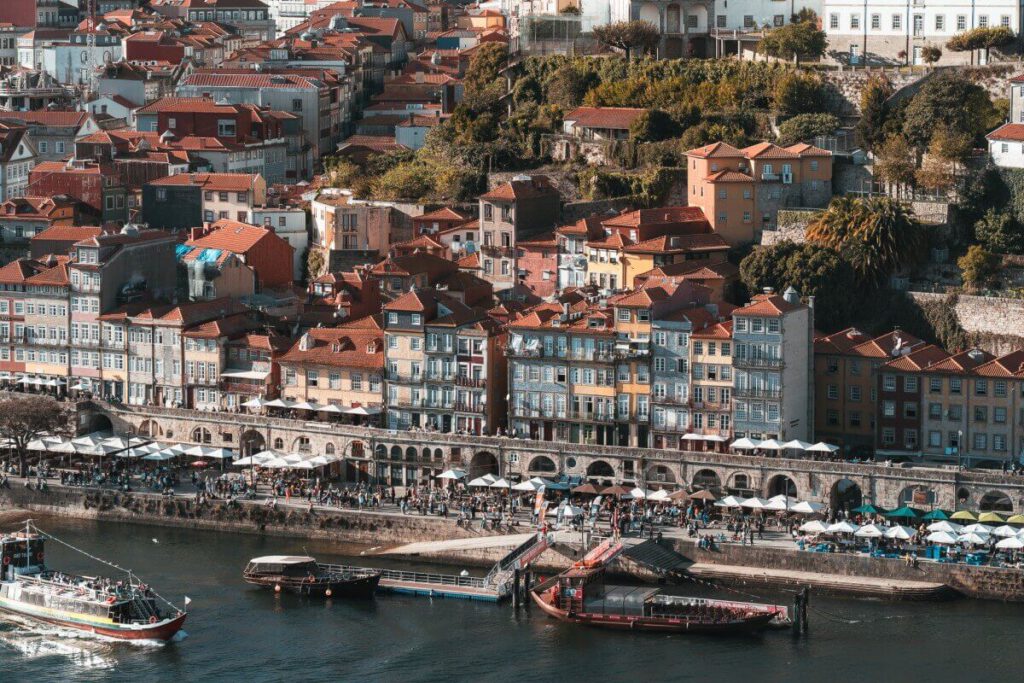
2. The Douro River
The Douro River characterizes the city with its special river landscape. A total of 6 bridges cross it in Porto. It has always been the most important transportation route for the region, especially for the port wine trade, which was transported here in special flat barges (Barcos Rabelos). You can still see these barges on the water today. However, they are now only used for tourism.
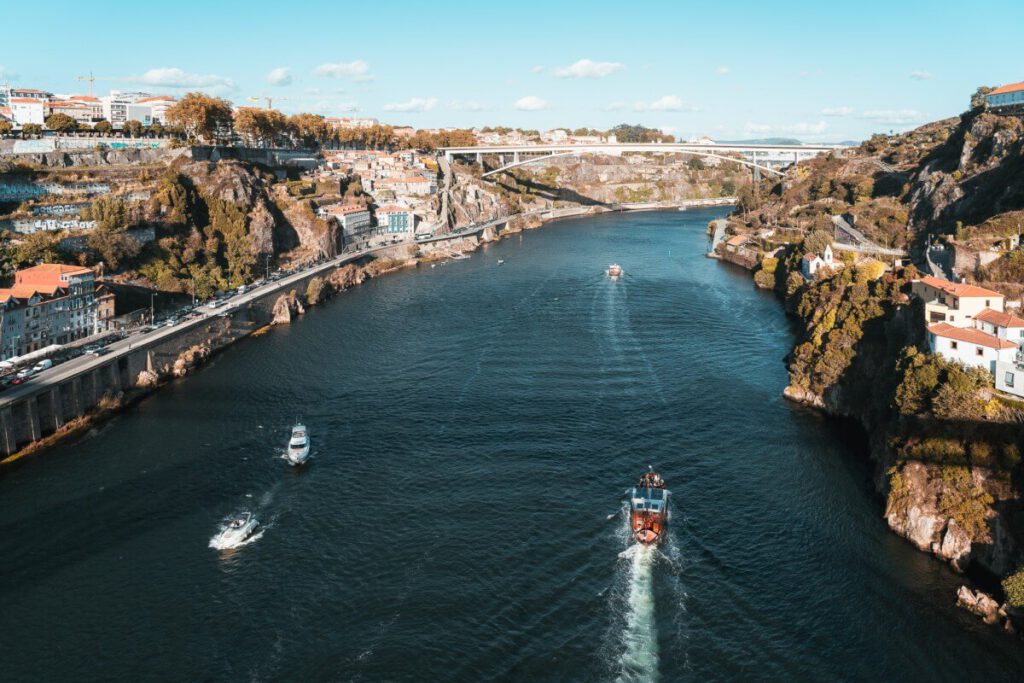
One of the most popular Porto activities and a highlight for many visitors to Porto is a river cruise where you can explore the city from the water.
3. Bridge Ponte de Dom Luis I
The striking “Ponte de Dom Luis I” bridge is one of Porto’s landmarks and connects Porto’s old town with Vila Nova de Gaia, the center of port wine production. On the bridge itself, you have a fantastic panoramic view of both banks of the Douro.
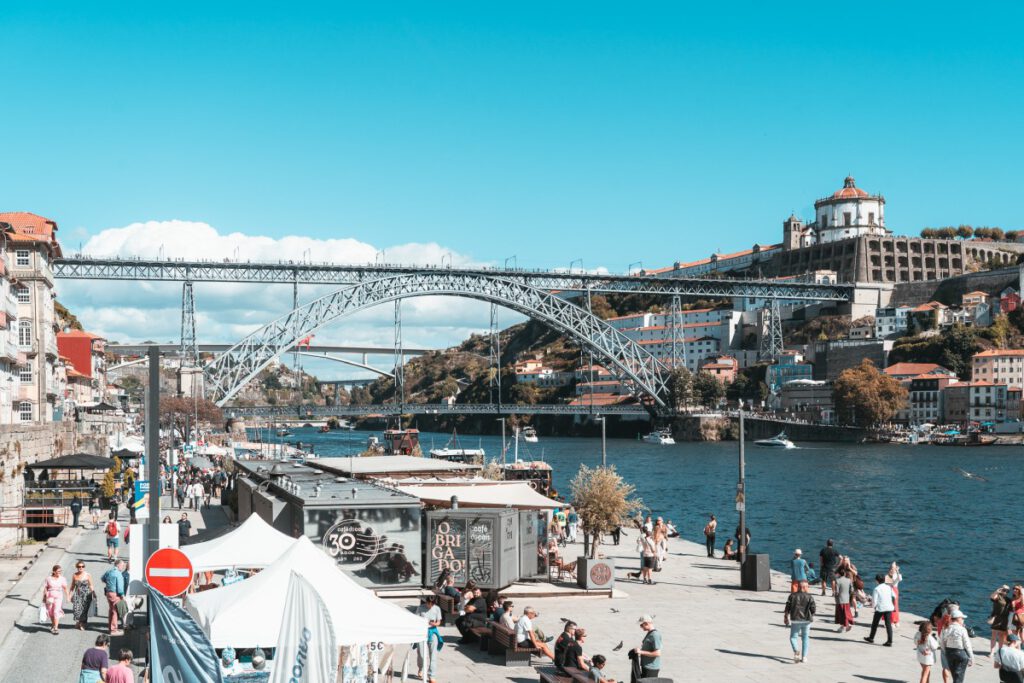
The bridge was designed by Théophile Seyrig, a close collaborator and former partner of Gustave Eiffel. And the 385-metre-long and 85-metre-high wrought-iron arch bridge is also somewhat reminiscent of the construction of the Eiffel Tower.
There are 2 floors over which you can also cross the bridge on foot:
- At the top, where the streetcars also run
- At the bottom, where the cars drive back and forth
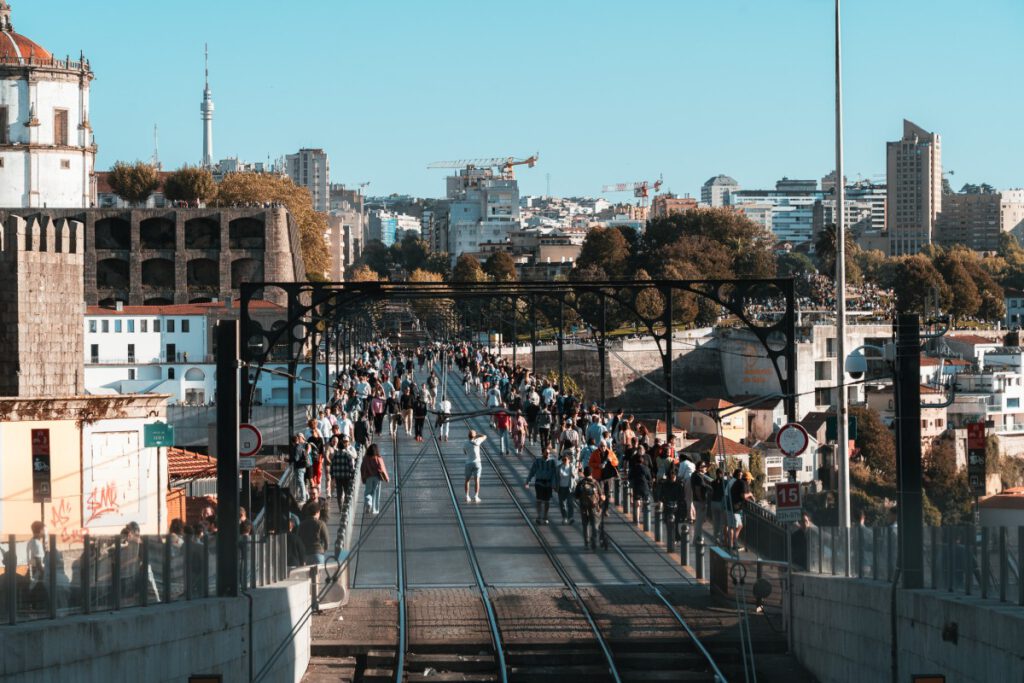
From the Ribeira, take the lower floor. If you are at the top of the cathedral, the upper floor makes more sense. Next to the bridge, there is also an elevator (Funicular dos Guindais), which you can take for a few euros and save yourself the strenuous walk up the stairs.
4. Vila Nova de Gaia – The center of port wines
You can find it on almost every corner throughout Porto. Whether in restaurants or at special wine tastings along the Ribeira: port wine, with its intense, spicy-sweet taste.
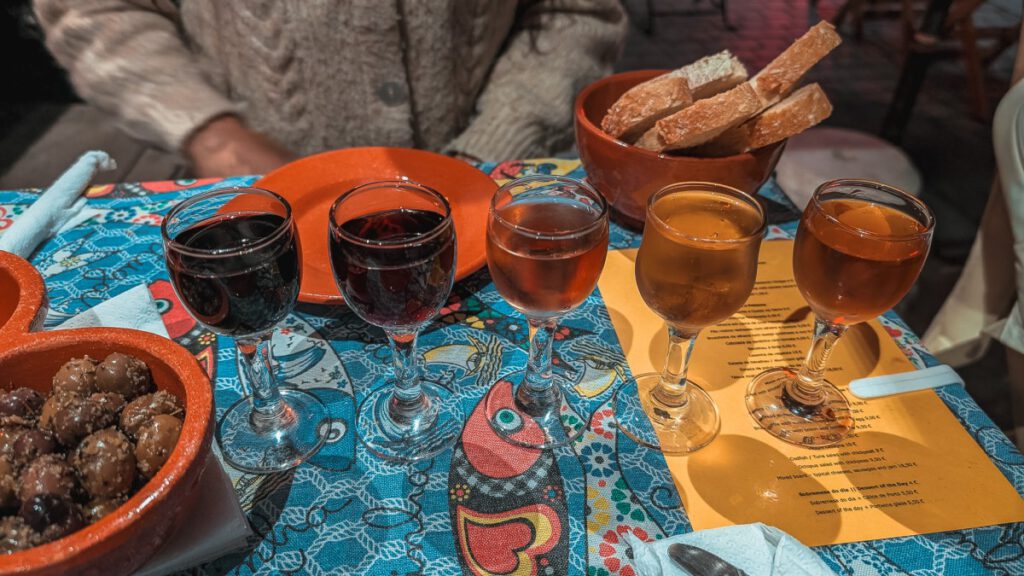
The Romans probably first planted the grapes in the Douro Valley around 2000 years ago, from which port wine was later made. According to legend, it was first discovered by British traders in the 17th century when they mixed the grape juice from the Douro Valley with brandy.
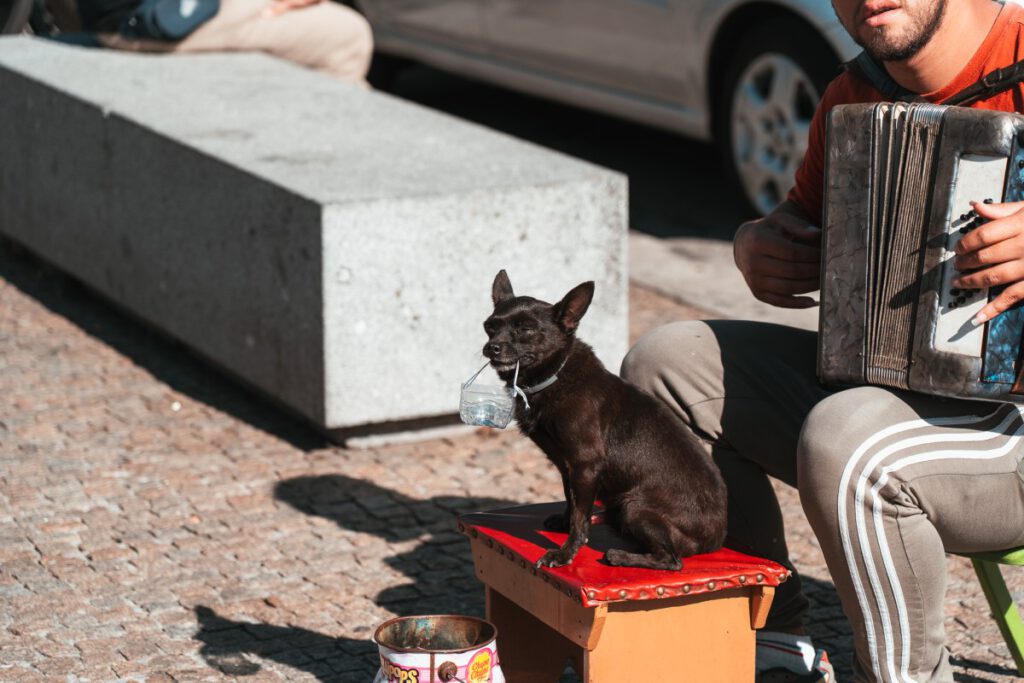
This preserved the wine for transport to England, but also gave it its special flavor. You can also recognize the influence of the British on port wine from some of the names of the wineries, such as Taylor’s, Graham’s or Cockburn’s, which are mostly only responsible for distributing the wine all over the world. The cultivation itself is completely in Portuguese hands. There are also German and Dutch port wine distributors in Porto, such as Kopke, Burmester, Andresen and Niepoort.
ℹ️ Vila Nova de Gaia is located on the other side of the Douro right next to Porto and you might think that it is simply a district of Porto. But this is far from the case, because in 1841 the municipality of Vila Nova de Gaia, which was formed from 2 settlements, was granted city rights.
However, the actual center of port wine production is not Porto, but the independent town of Vila Nova de Gaia on the opposite side of the Douro. As you simply have to walk over a bridge, many people think that Vila Nova de Gaia is part of Porto. But that’s not quite true. Nevertheless, a visit to Porto’s neighboring town is definitely part of a city trip.
The reason why wine production was moved to the Douro banks of Vila Nova de Gaia and not Porto was quite simple: less tax.
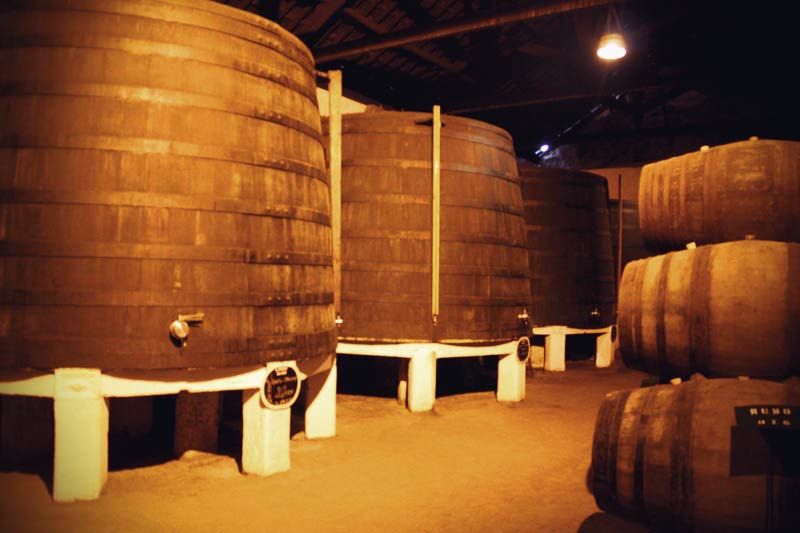
You can find out all about the history, origins and different types of port wine on a tour of one of the port wine houses.
You can book these online and often explore several of the port wine houses, including tastings:
But you can also go directly to the houses and take a guided tour. The best known are Taylor’s and Graham’s.
I myself was at the Feirrera port house, which was run for many years in the 19th century by the lady Dona Antónia Adelaide Ferreira. She set the course for the worldwide success of the house. The tour ends with what is probably the most important part: a wine tasting in the cellar.
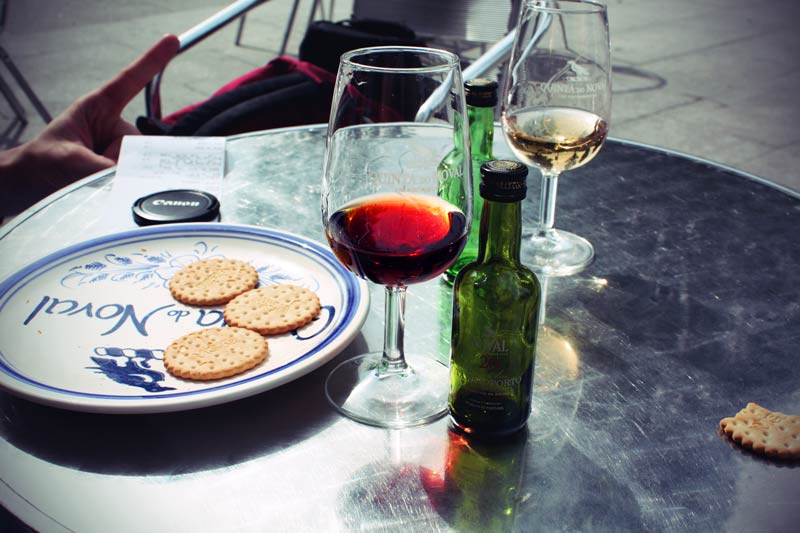
5. Cable car Teleférico de Gaia
If you want to look out over the rooftops of Vila Nova de Gaia or simply go up to the Ponte de Dom Luis I without having to climb long flights of stairs, then a ride on the cable car is a very good idea.
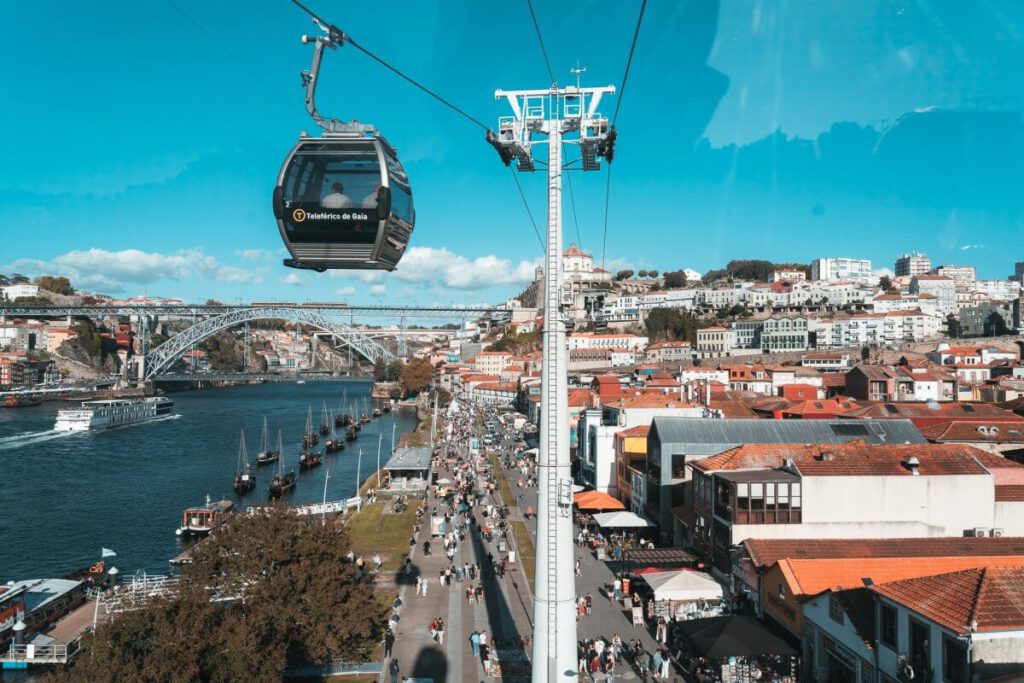
The “One Way” Teleférico tickets are not exactly cheap at €7 for just a few minutes’ ride, but the trip is worth it, especially if you want to save time.
6. Cathedral of Porto (Sé do Porto)
In my opinion, a visit to Porto Cathedral is a must-do that you should definitely not miss out on. The Gothic cloister built in the 14th and 15th centuries with its blue azulejo walls is particularly impressive. They depict scenes from the biblical Song of Songs. But you should also not miss the view from the cathedral tower over the whole of Porto.
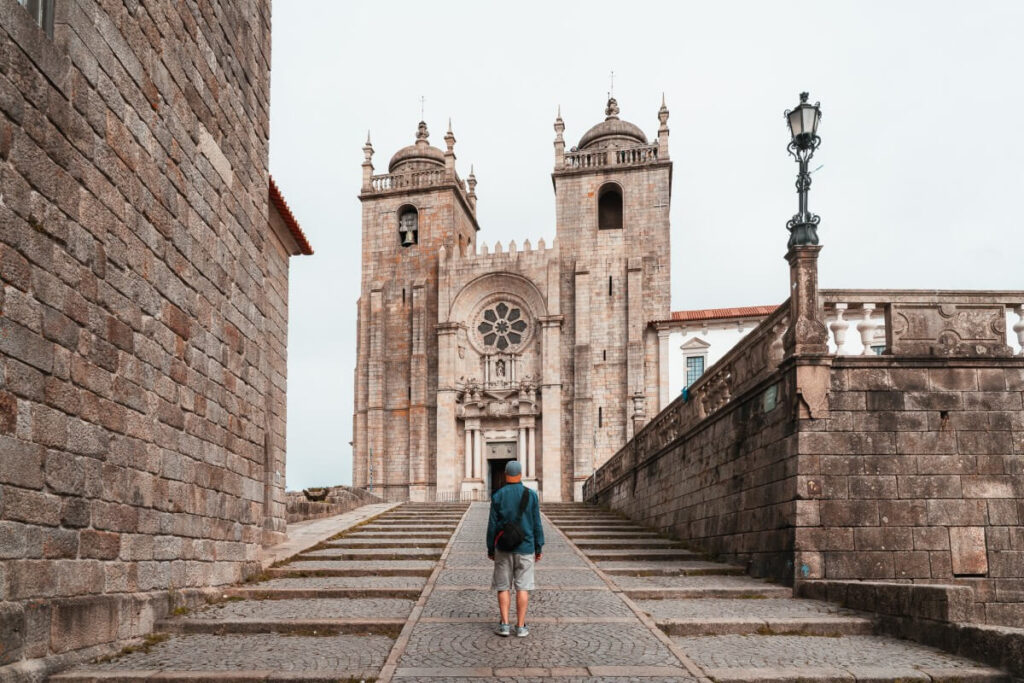
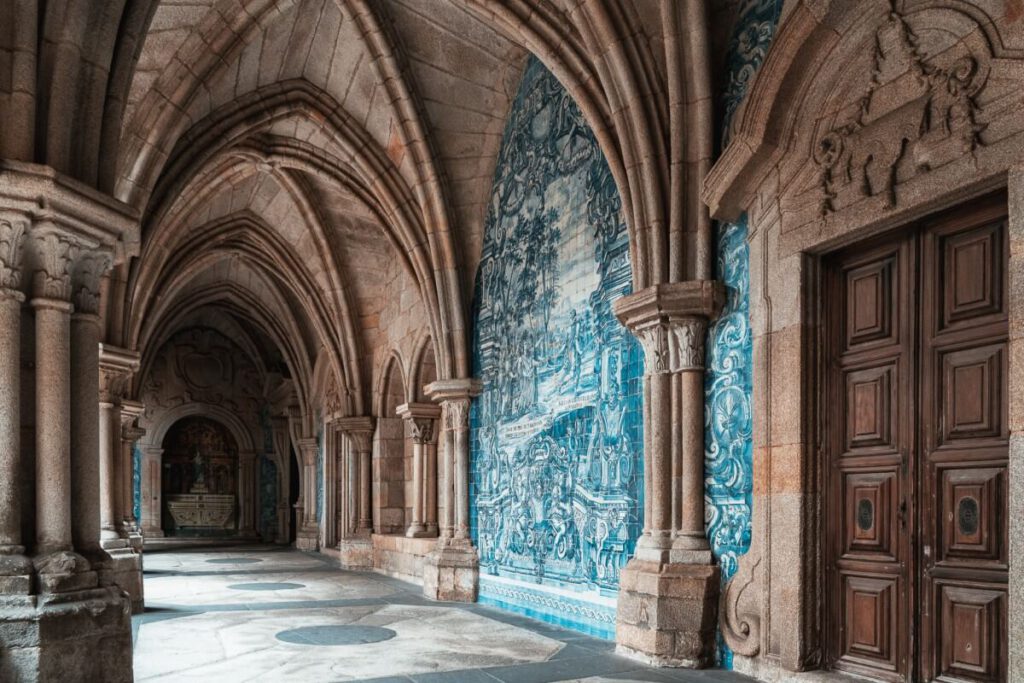
You can get normal admission tickets without a guided tour directly on site at the ticket office, but you can also get them online in advance: Tickets for Porto Cathedral.
💡 Tip: Guided tour through the cathedral complex of the cathedral
If you would like to discover all the information about the history of the cathedral and interesting details, then you should take part in a guided tour with an expert:
Highlights of the tour:
- Guided tour of the cathedral, the cloister and the Cabido house with a certified guide.
- Discover fascinating facts, legends and exciting stories about the cathedral.
- Enjoy the panoramic view of Porto from the upper floors of the cathedral and the tower.
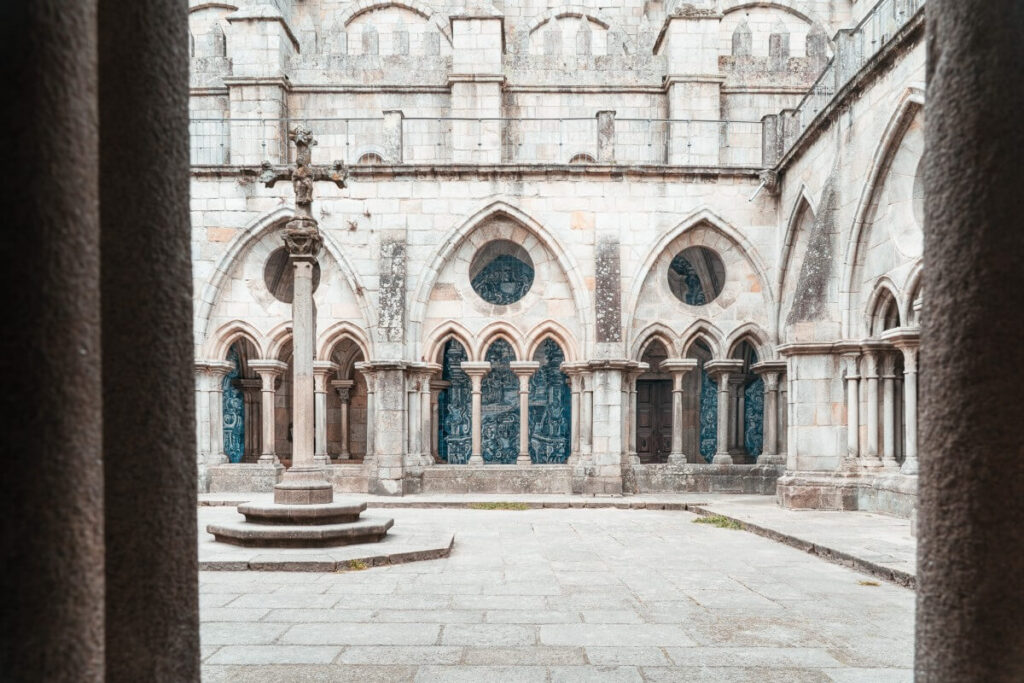
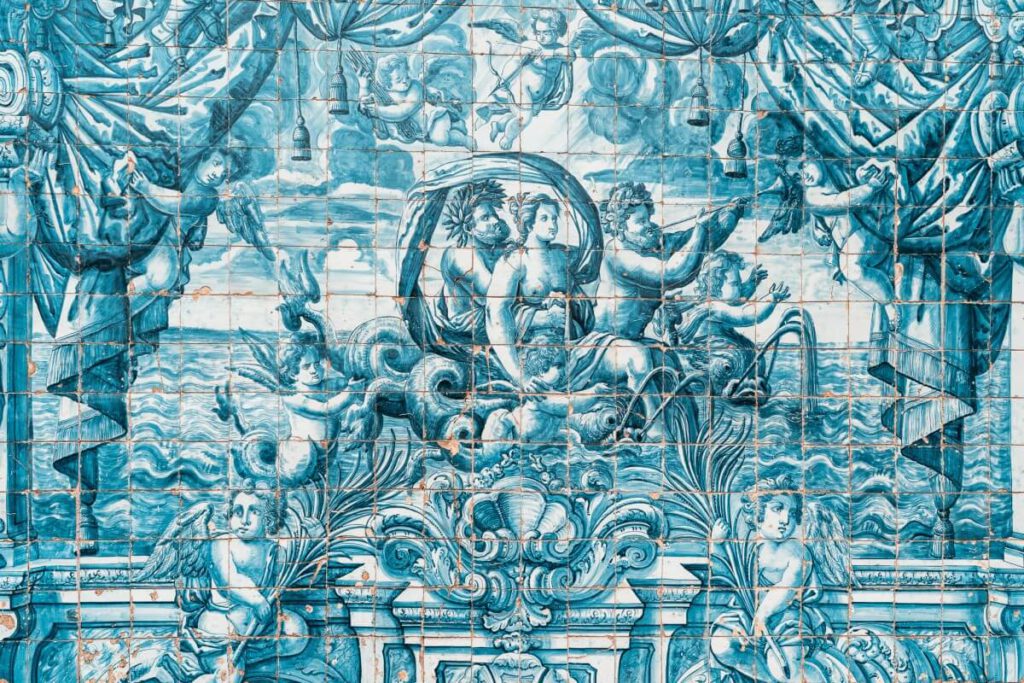
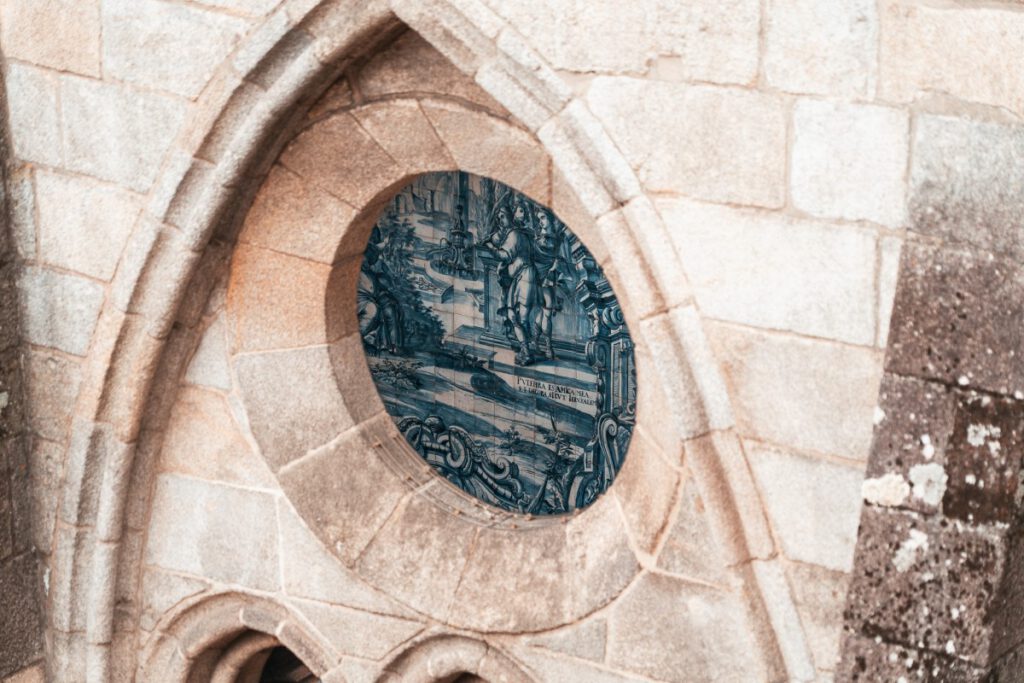
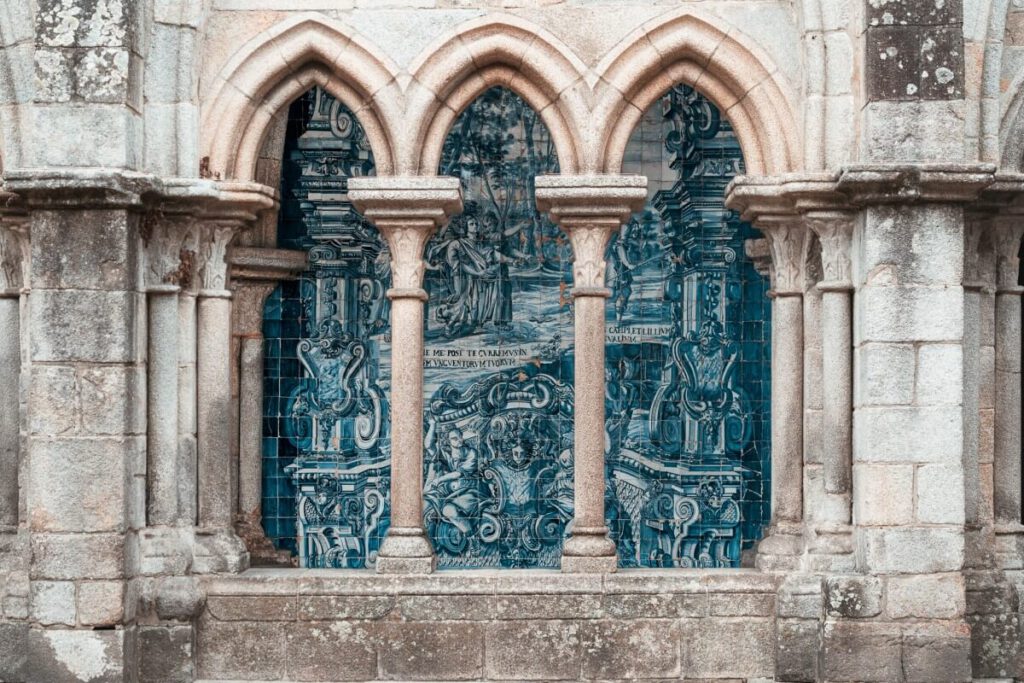
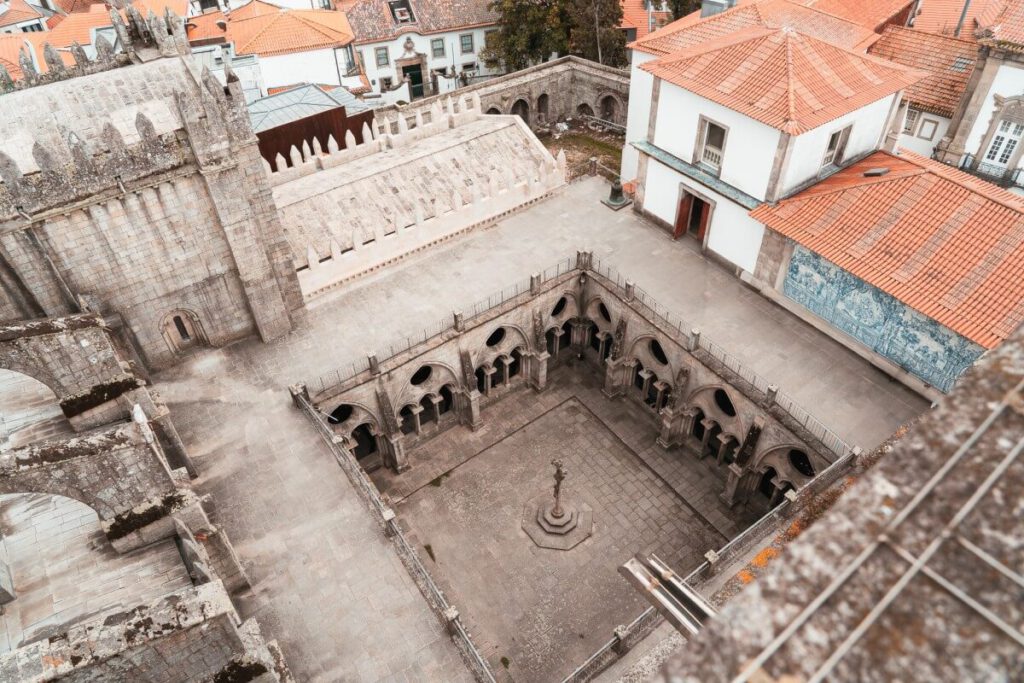
7. Rua das Flores and Igreja da Misericórdia
Rua das Flores is one of the most beautiful and picturesque streets in Porto. It was laid out at the beginning of the 16th century (1521) during the reign of King Manuel I and was one of the first planned streets in Porto. There were once numerous gardens, flowers and balconies decorated with flowers here, which is where the name “Street of Flowers” comes from.
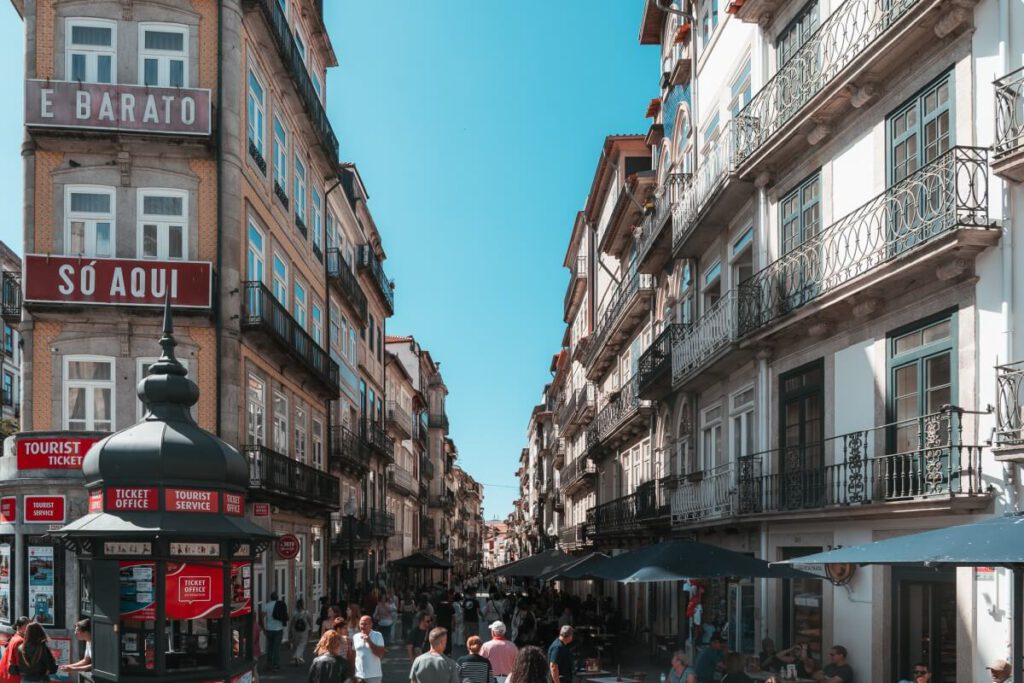
Today, Rua das Flores is a lively street with many small boutiques, art galleries, cafés and restaurants offering artisan products and regional specialties.
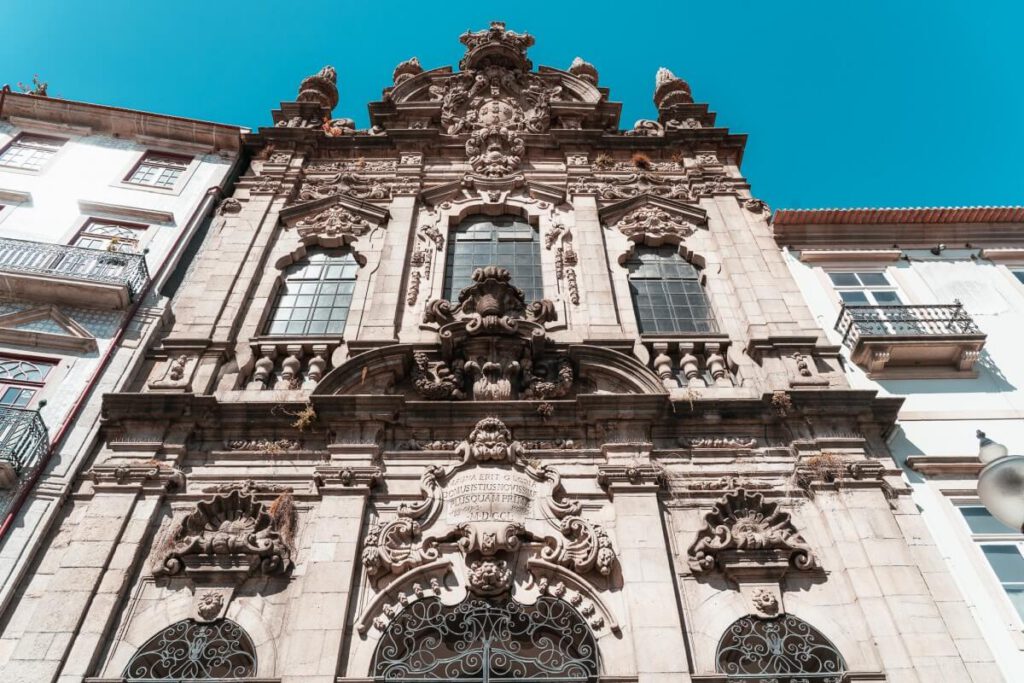
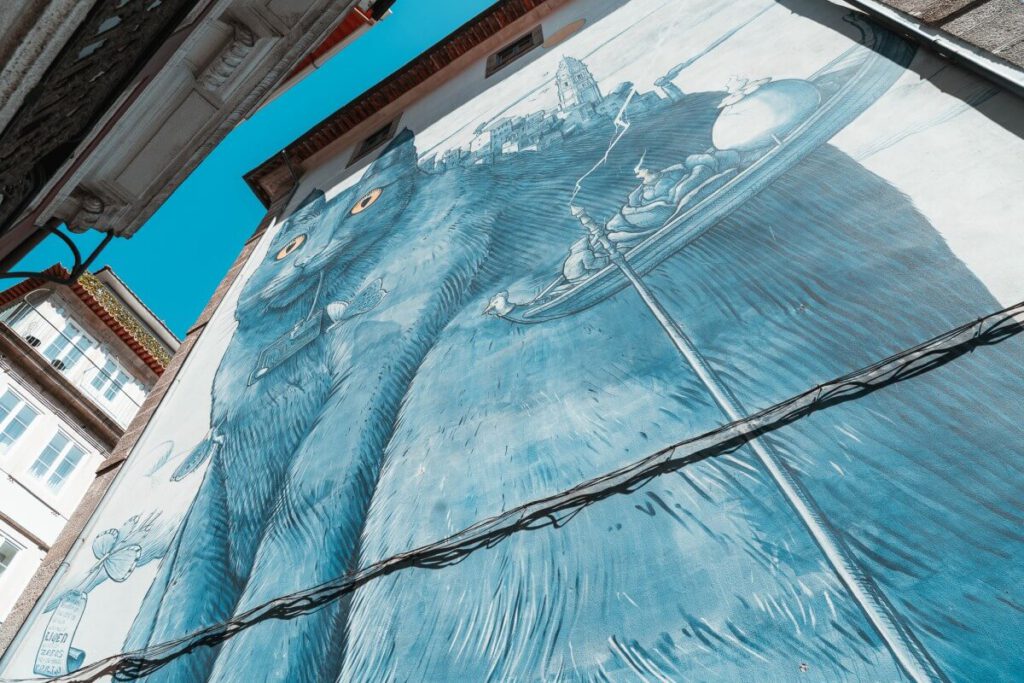
One of the most important sights along the street is the Igreja da Misericórdia, a baroque church that blends harmoniously into the row of houses.
8. Igreja e Museu de São Francisco do Porto
Even from the outside, the 14th century Franciscan church Igreja des São Francisco do Porto is a gem. But the church reveals its true splendor in its spectacular interior:
I feel like I’m inside a stalactite cave, with liquid gold slowly dripping down the pillars from the ceilings and walls. The radiant gold reflects the light in a fascinating way and envelops the room in a warm, vibrant glow that enchants my senses and overwhelms me. The delicately crafted decorations are so impressive that they create an almost magical atmosphere. Compared to the splendor of the church, I feel small and insignificant.
It is particularly worth a visit in the evening, when the setting sun shines through the windows of the church. The ceilings, pillars and walls are adorned with one of the largest and most elaborate collections of gilded wood carvings (talha dourada) in Europe, decorated with fine details and floral patterns. The gold leaf reflects the evening light beautifully in the room.
However, as the interior of the church is so special, it is forbidden to take photos.
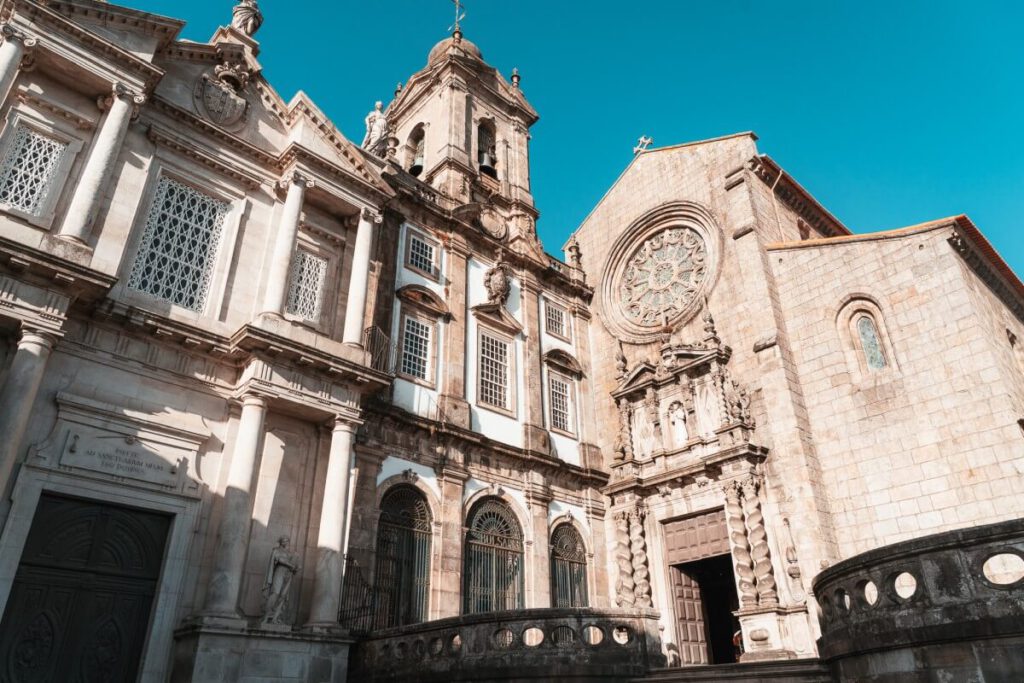
You can get your ticket to the church in the building opposite, which also houses the museum , which is included in the ticket price. You should definitely visit that too. I found the catacombs in the basement very fascinating, where there are many tombs in the sides of the walls and also under the floor. There is also an ossuary with thousands of bones of brothers and benefactors who were once buried in the tombs.
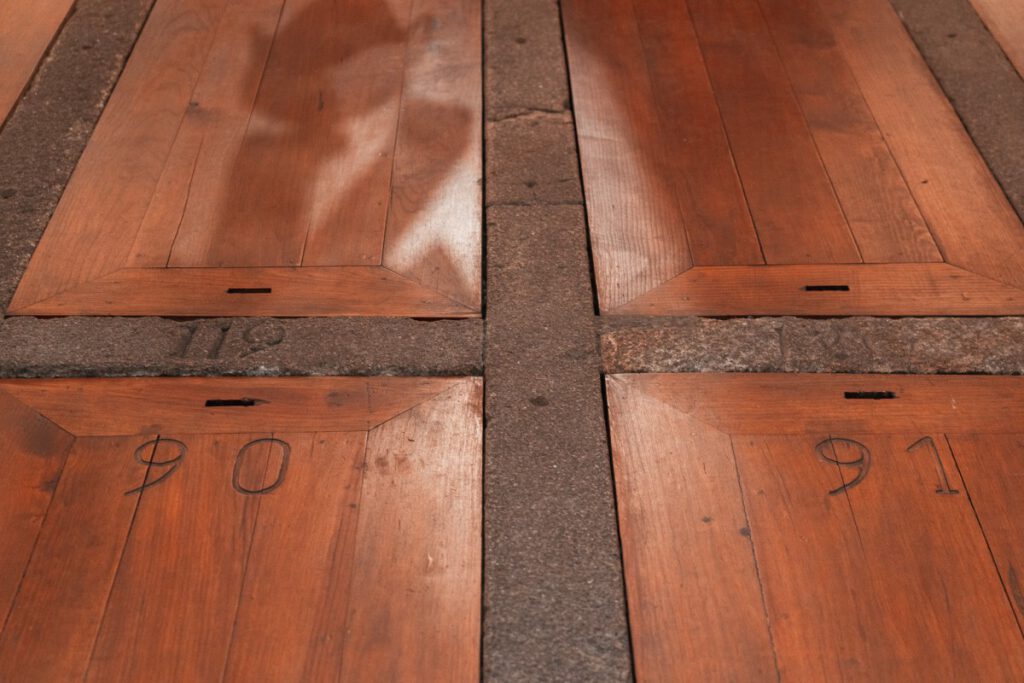
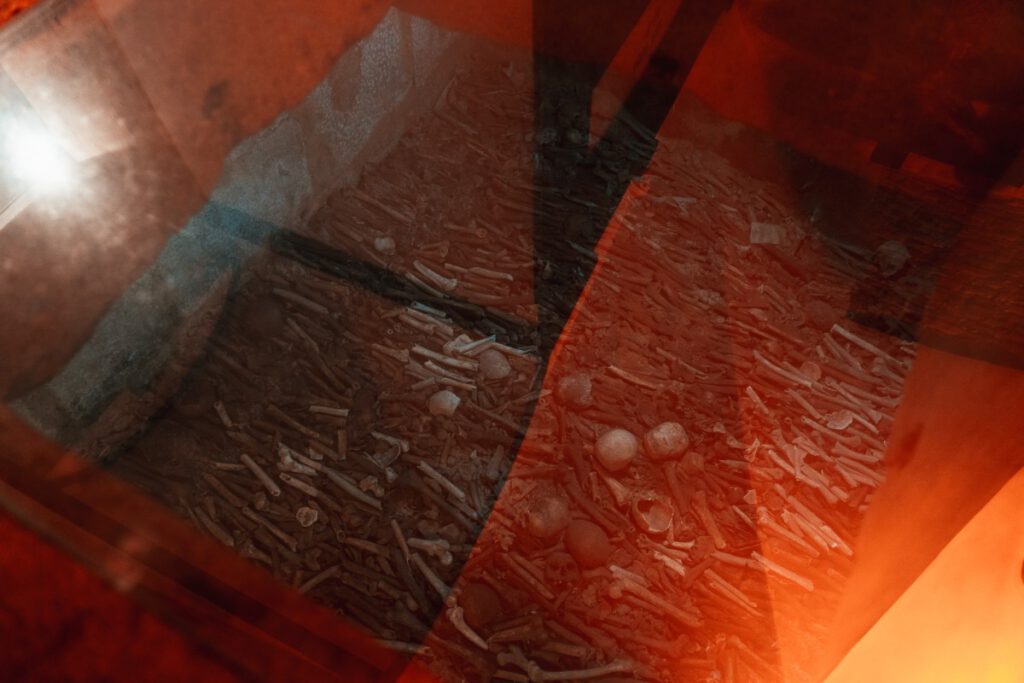
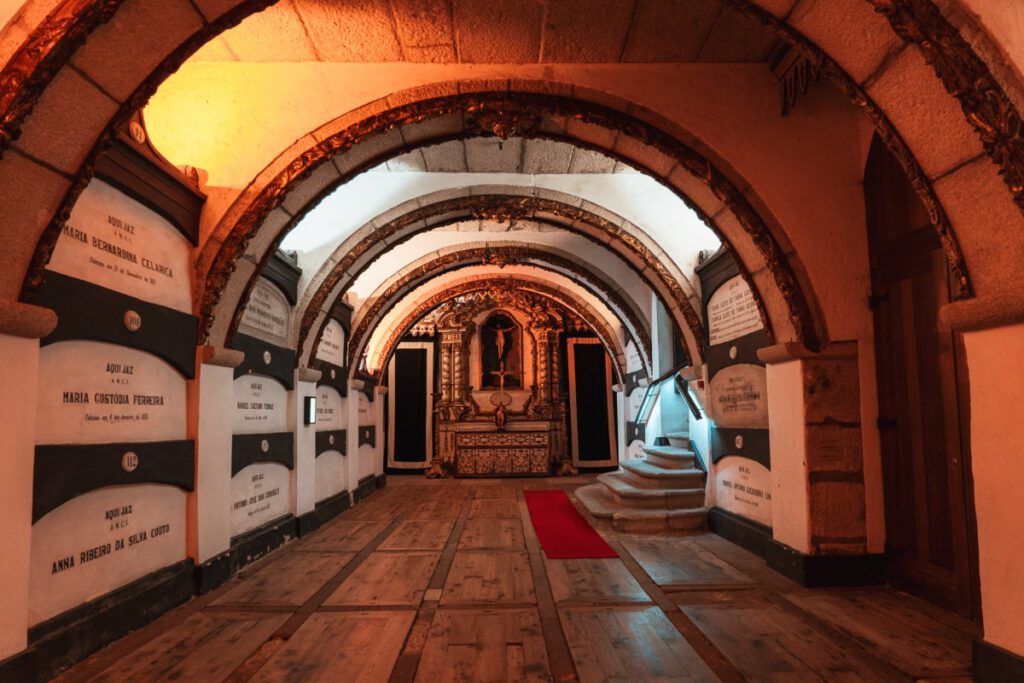
9. The Stock Exchange Palace – Palácio da Bolsa
The Palácio da Bolsa is probably the most magnificent building in the entire city and is therefore well worth a visit. It was built in the 19th century as the seat of the Chamber of Commerce. This influential institution, which represented the interests of Porto as a trading location, became quite wealthy thanks to the port wine trade and wanted to show this to the outside world. Today, the palace is therefore also a symbol of Porto’s rich trading history.
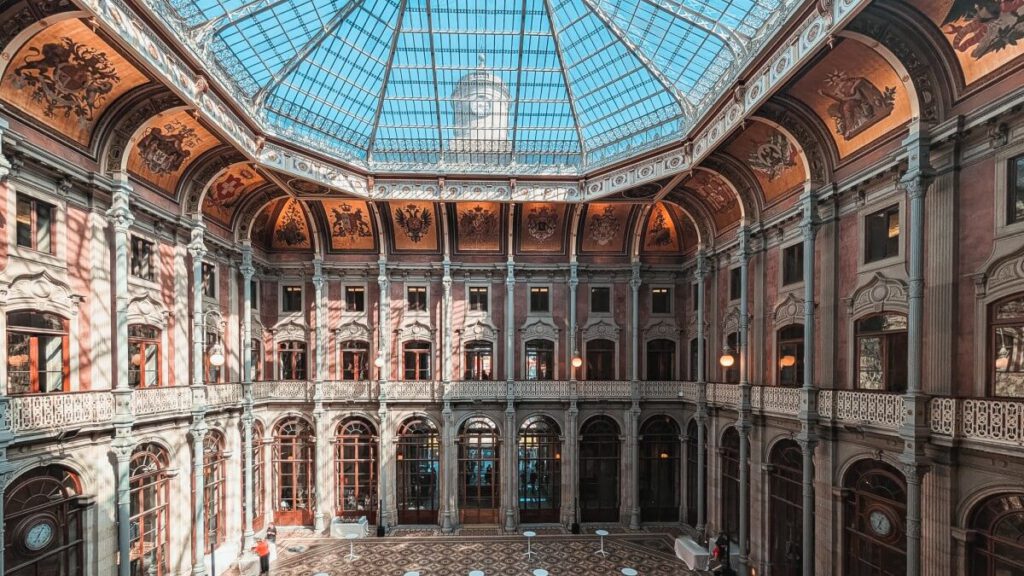
You can only see the impressive interior of the palace as part of a guided tour, which lasts around 30 minutes. These are only available in English at certain times and you can buy them directly on site at the ticket office. However, it is advisable to reserve a time slot online in advance, especially during the peak summer season. You can do this on the official website. There are also sometimes events taking place. There are no guided tours on such days.
💰💰💰 If you have the necessary “small change”, you can also hire the halls and rooms of the Palácio da Bolsa for events.
During the tour, you will learn a lot about the history of the Chamber of Commerce and the secret details of the rooms in the palace.
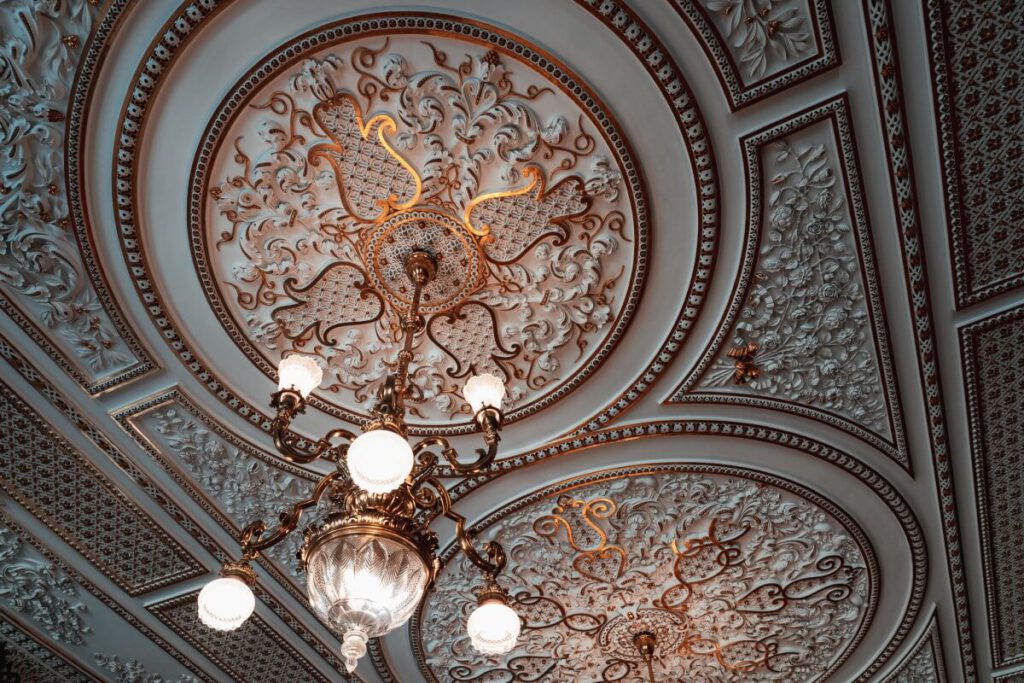
The Golden Hall is characterized by sumptuous furnishings and many gilded details. The Assembly Hall (Salas das Assembleias Gerais) looks as if it is made entirely of wood, but is actually largely made of plaster. The absolute highlight, however, is the Moorish Hall (Salão Árabe), which will leave you speechless with its intricate ornaments and luxurious glittering decorations.
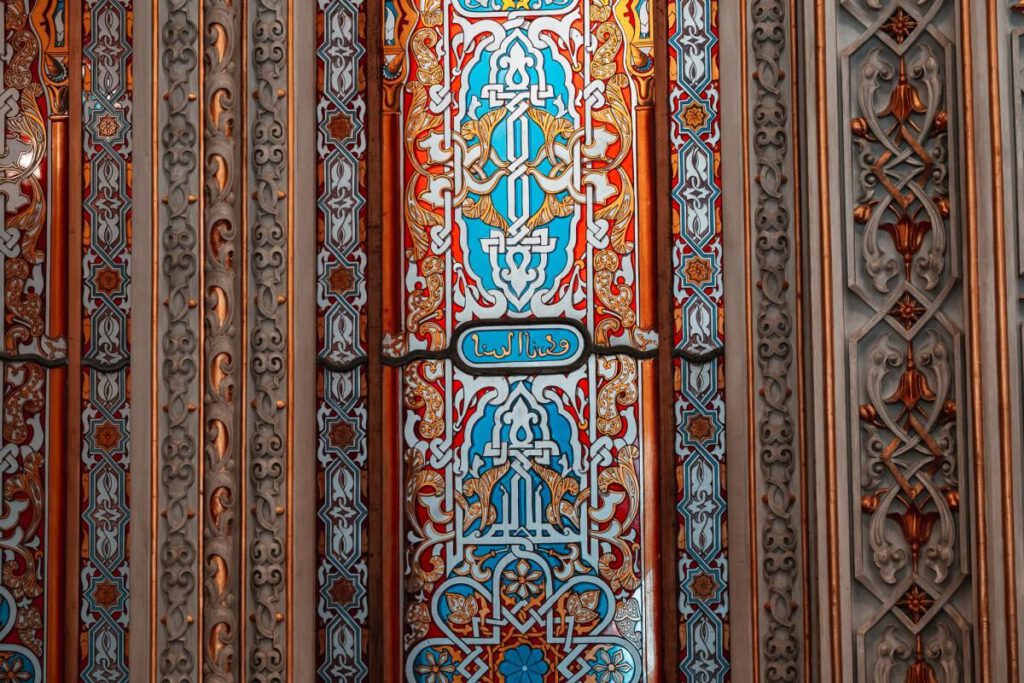
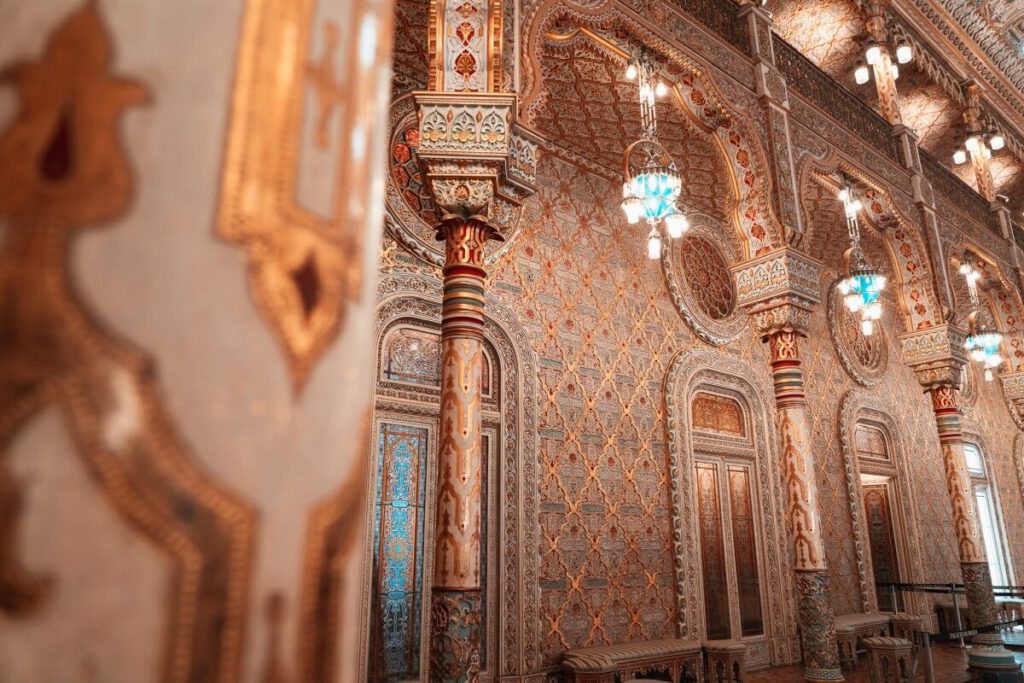
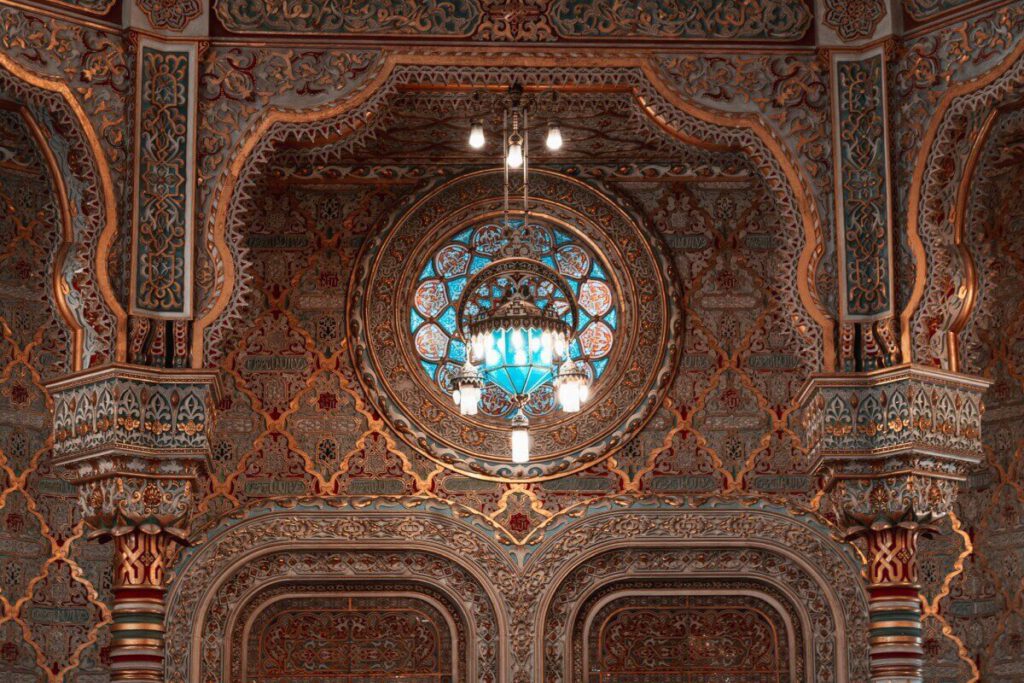
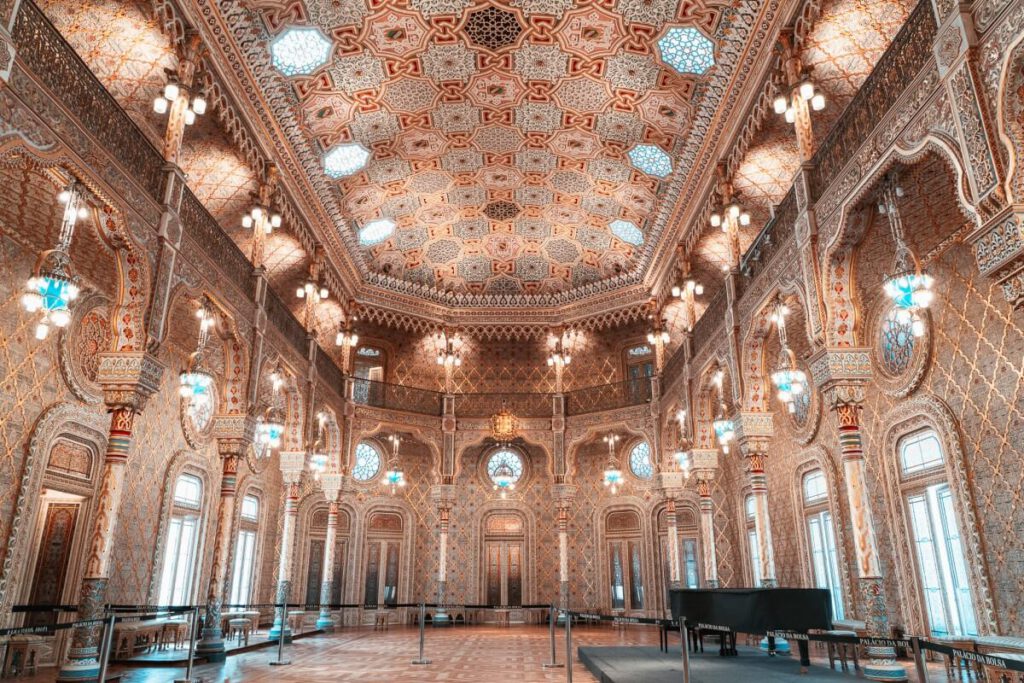
The room was once built as a symbol of power. At the time, it was a trend to build such rooms. It was modeled on the Alhambra in Granada (Spain).
10. Bookstore Lello
Opened in 1906 by the Lello brothers, this bookshop is now one of Porto’s most popular attractions. No wonder, as the time-honored library has the atmosphere of Hogwarts from the Harry Potter books:
- Bookshelves stretching up to the ceiling of the upper floor
- Wooden bridges with hand-carved Art Deco railings that wind from one end of the room to the other.
- Paintings and busts of the founders and famous writers of a bygone era.
In fact, Joan K. Rowling is said to have found inspiration for her novels here.
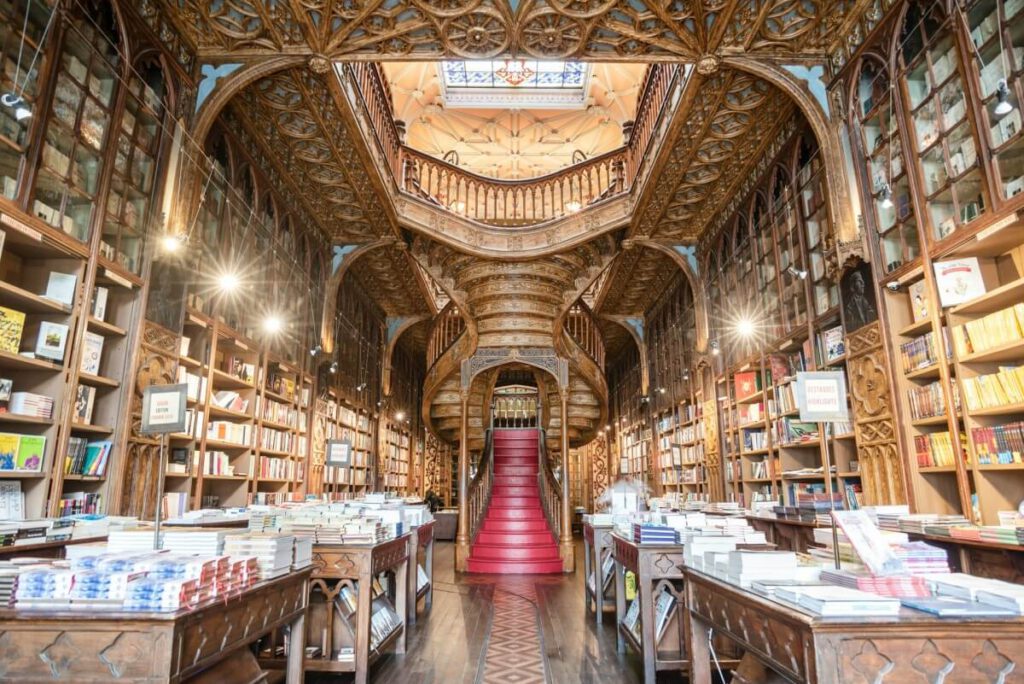
However, admission is not exactly cheap due to the hype and to be honest I found the visit to the library itself rather disappointing because it was simply extremely crowded. I felt like a squashed sardine. However, I was also there at lunchtime on a rainy Saturday, one of the worst possible combinations of visits.
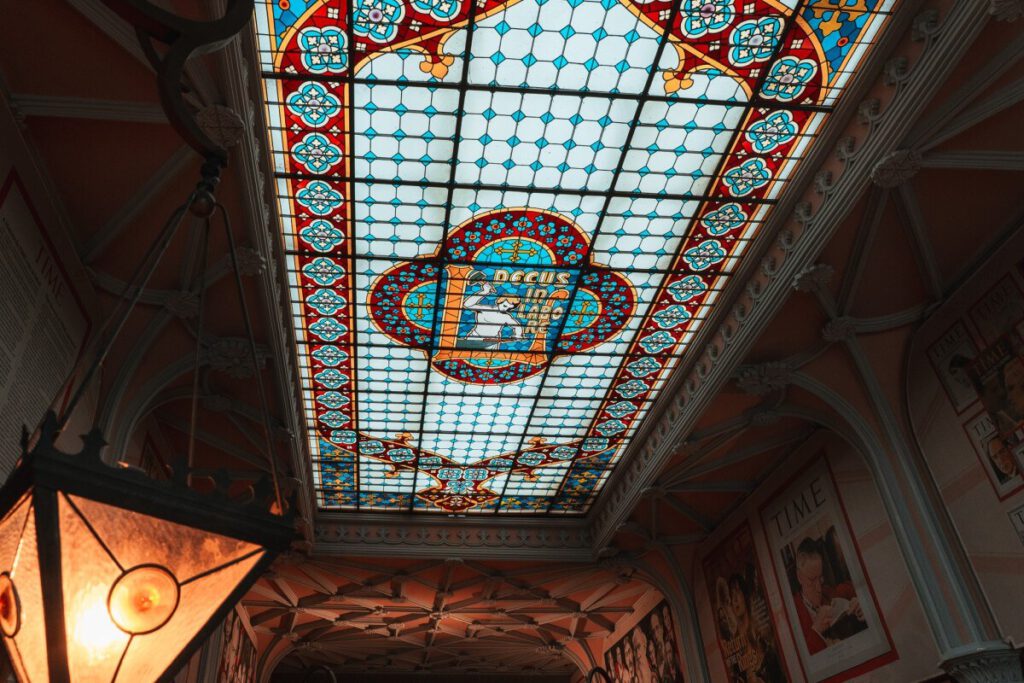
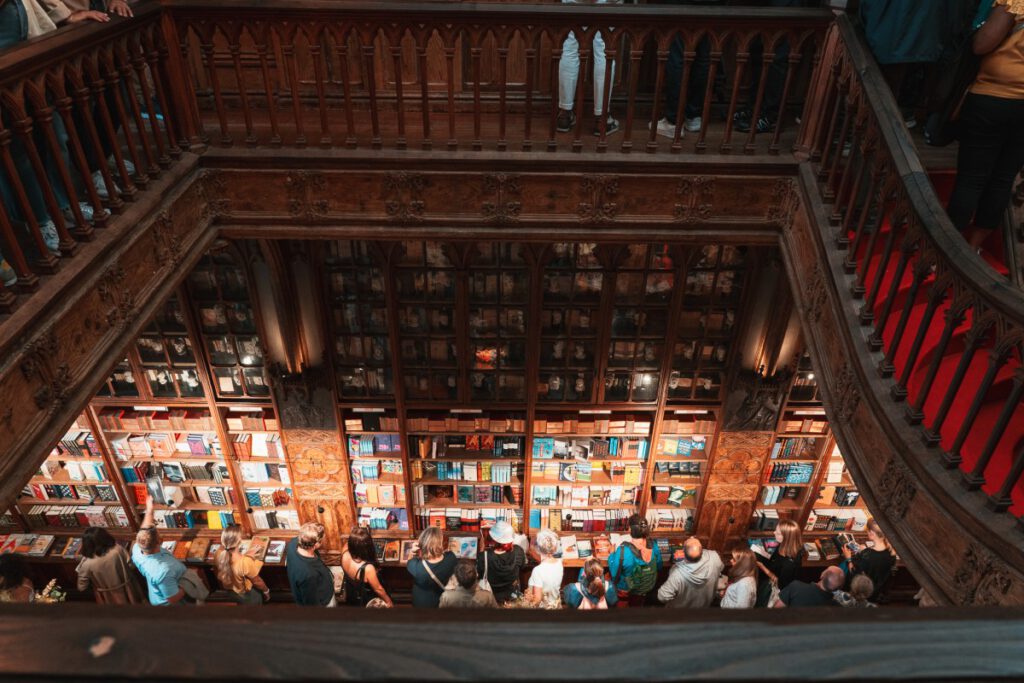
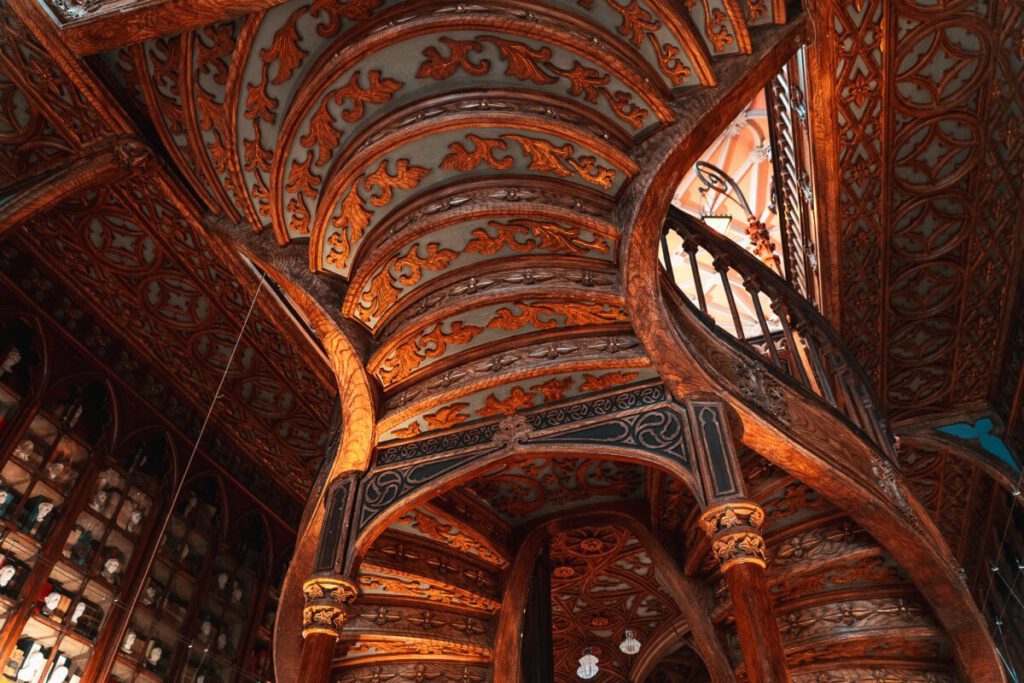
If you can make it, I think it’s best to visit at the earliest possible time, because then you can still see the library without the crowds. Lello opens at 9:00 am.
However, the ticket system is a little complicated. You can only buy tickets online on the website. You select a time slot at which you can then visit the library. The times are then shown on the signs in front of the entrance. You have to queue up in the line that shows your booked time on the sign. Sometimes there are also colors such as purple on the time signs. However, this has no significance for your ticket.
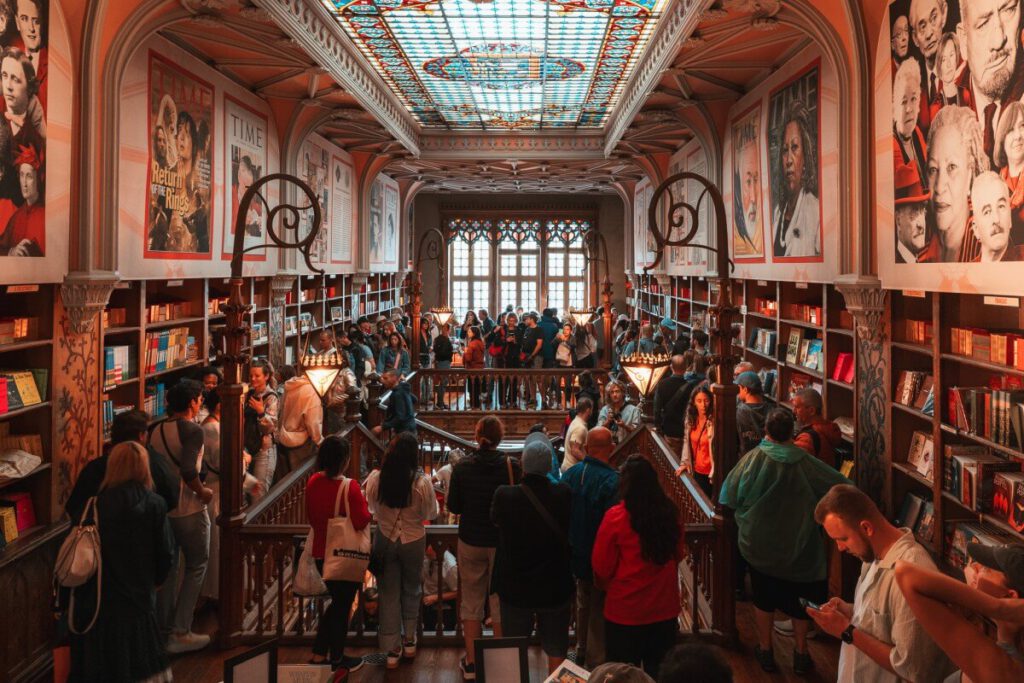
If you come to the library spontaneously, you can also try to buy a ticket on site using a QR code. But if you’re unlucky, everything will already be fully booked at that time. I therefore recommend that you plan your visit in advance and reserve a ticket for a specific time.
The following options are available:
- Silver for 10 €: You simply get access to the library at the time you book. If you buy a book, the €10 will be deducted from the price.
- Gold for €15.95: In addition to admission, this ticket includes a selected book from the limited edition “The Collection” by Livraria Lello.
- Platinum for €50: This includes a guided tour of the Gemma room, which contains first editions, rarities and unique books. Other visitors are not allowed in there.
11. Torre dos Clérigos
Porto’s cityscape is characterized by its many churches. These include the eye-catching, 76-metre-high Torre dos Clérigos bell tower, which is also one of the city’s most iconic landmarks. You can see it from almost everywhere from a distance. No wonder: it is 76 meters high, has six floors and once even served as a landmark for sailors.
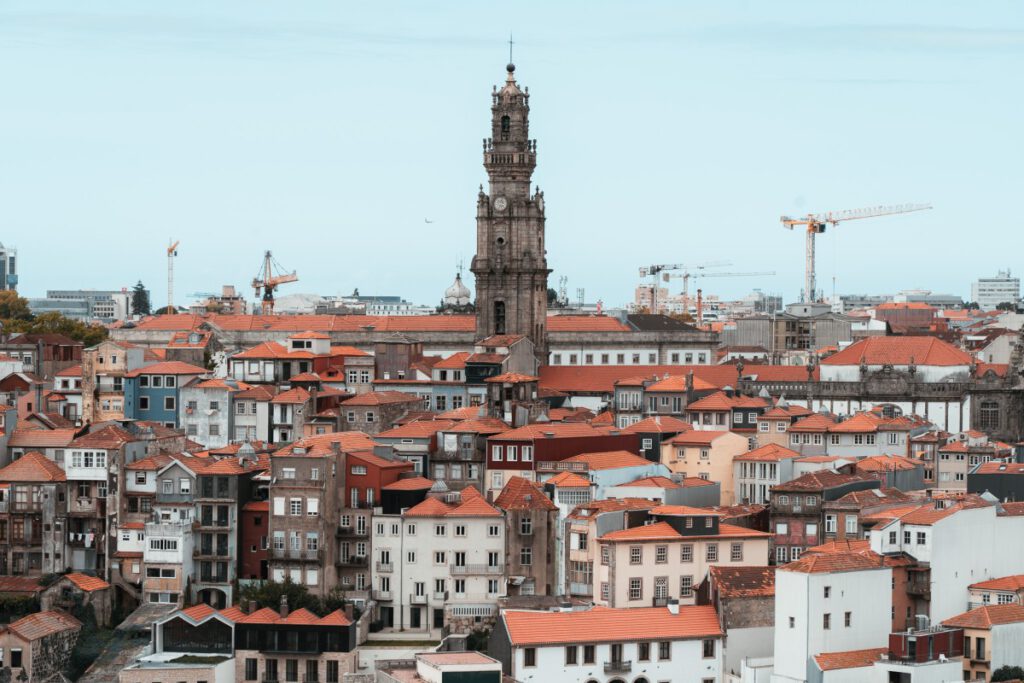
If the 225 steps are not too much for you, you can also enjoy a beautiful view over Porto from the viewing platform at the top. A ticket for this costs €10. Especially cool: You can visit the tower from 19:00 and until 23:00 for half the price and see the city from above at night.
12. Churches Igreja do Carmo and Igreja dos Carmelitas
This sight is actually 2 churches standing right next to each other, but they can be visited separately:
- Igreja do Carmo: Costs €7 admission with a walk-on roof.
- Igreja dos Carmelitas: There is no entrance fee and the museum is also free.
Both are closely associated with the Carmelite Order.
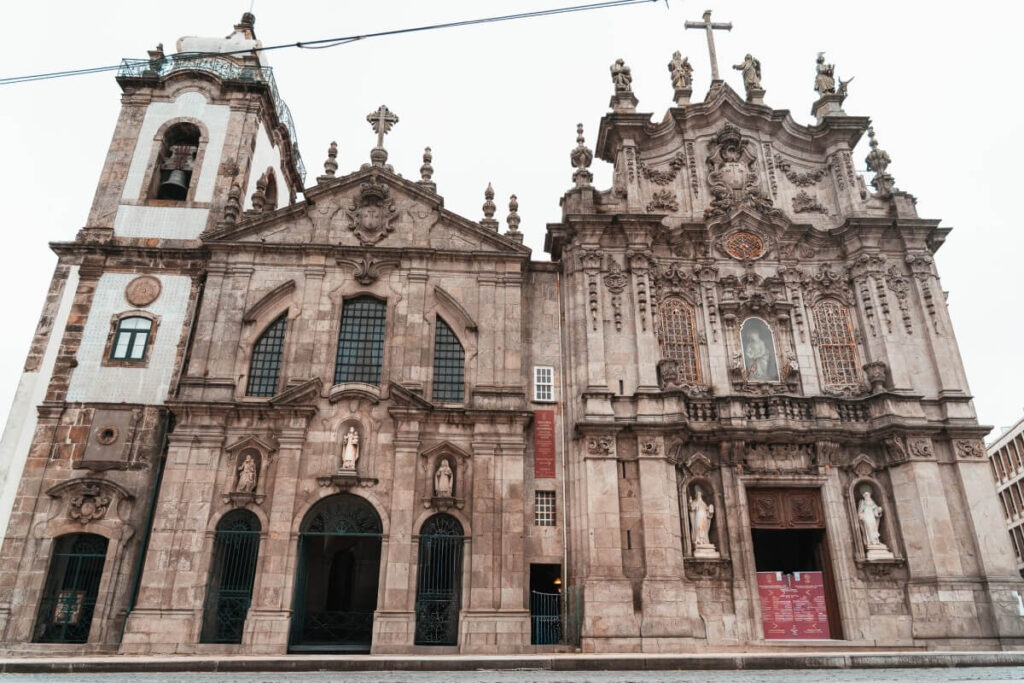
The Igreja do Carmo is a popular photo motif, especially because of its exterior wall decorated with blue azulejos. It was built between 1756 and 1768 in the late Baroque style.
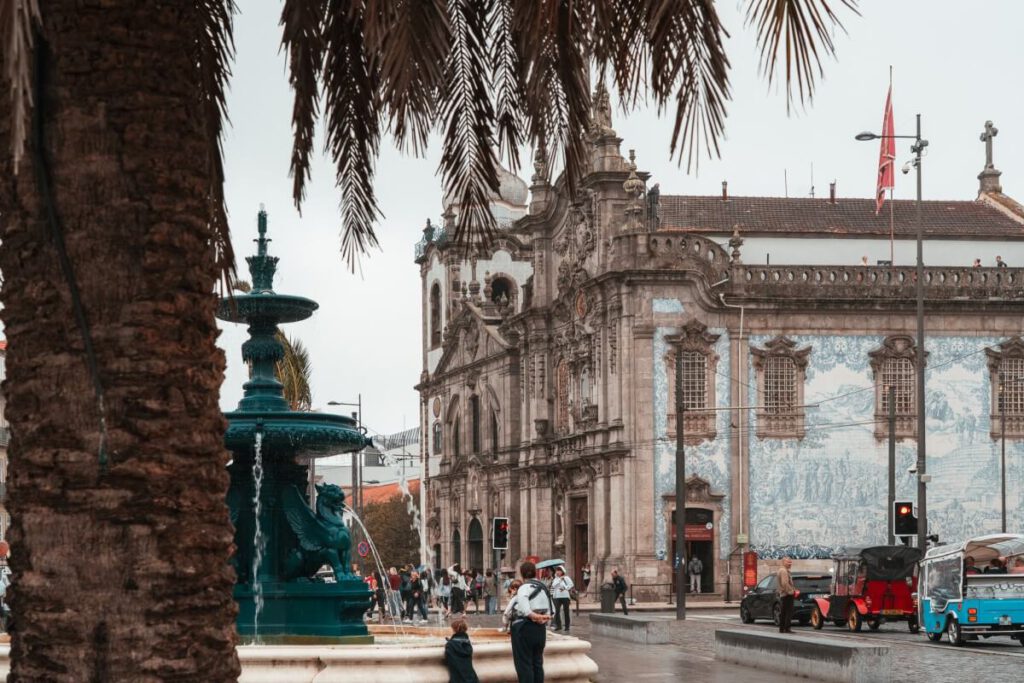
Inside, however, I found the Igreja dos Carmelitas, which was completed in 1628, more impressive with its opulent rococo decoration, characterized by the many stucco works and ceiling paintings. The museum is also free of charge and very atmospheric.
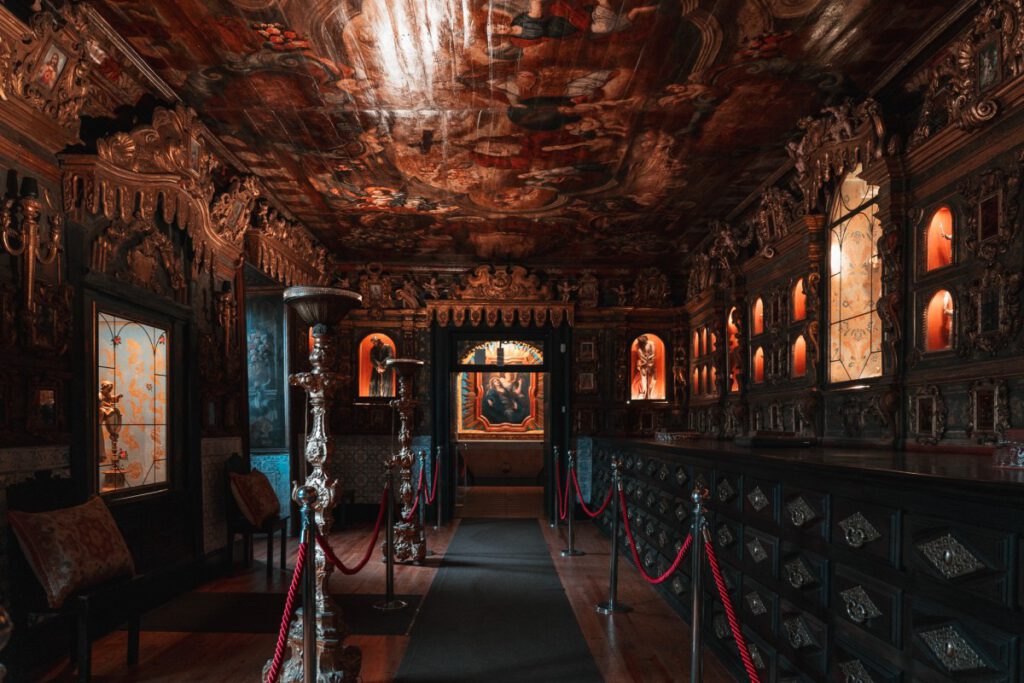
13. Banco de Materiais: The material bank for azulejos
In a small, unassuming building on Praça de Carlos Alberto, there is a collection of various ceramic tiles (azulejos), ironwork and statues, all of which were rescued from old, dilapidated buildings in the city of Porto and have now been made available to the public again.
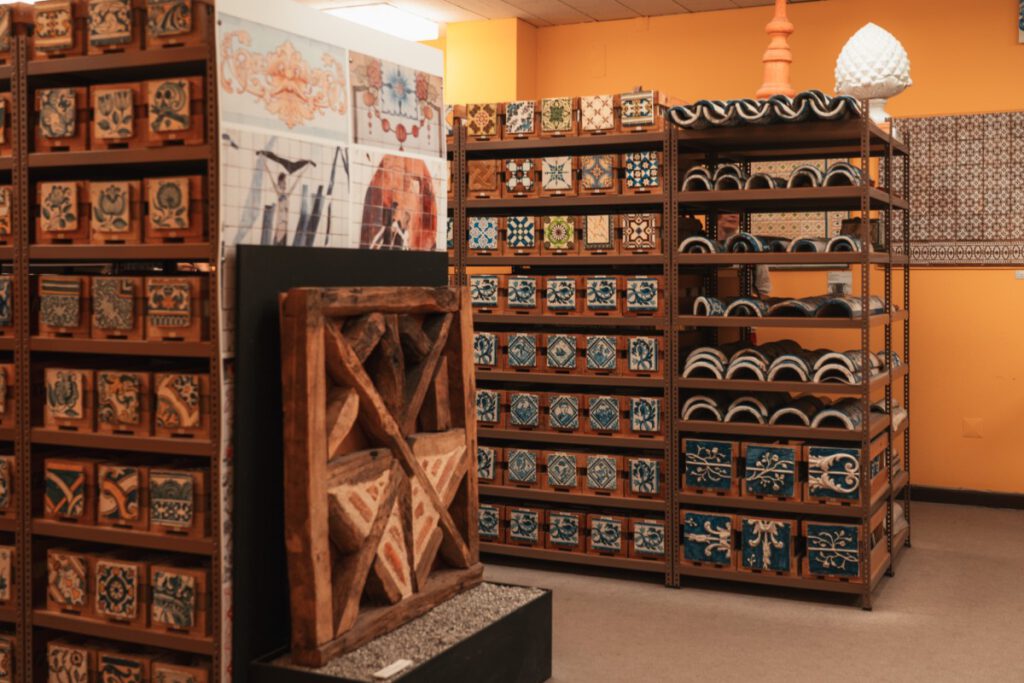
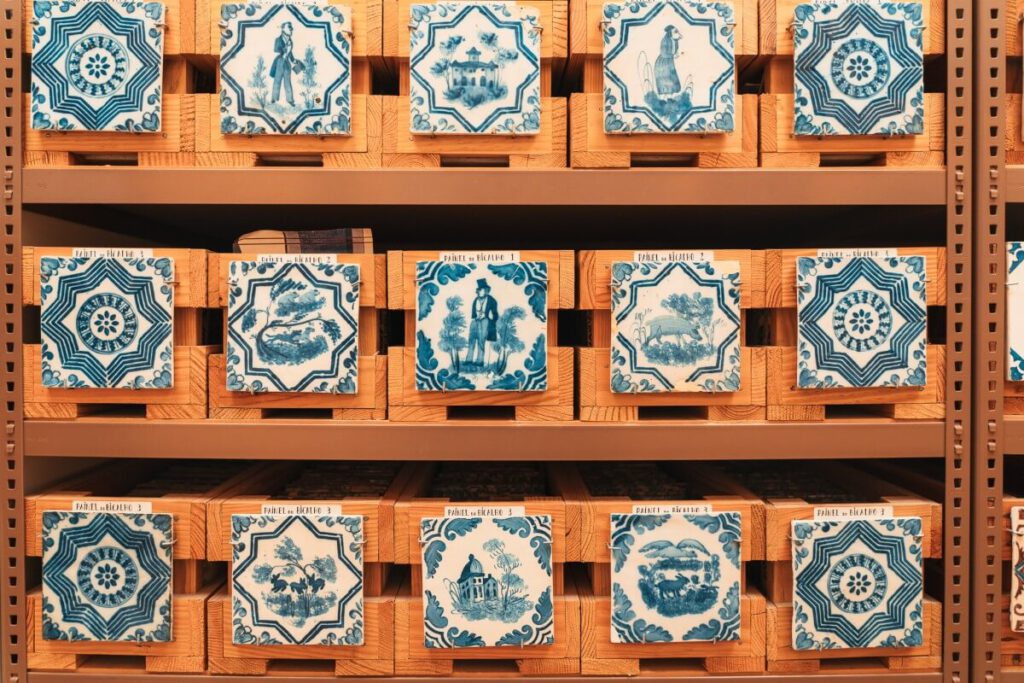
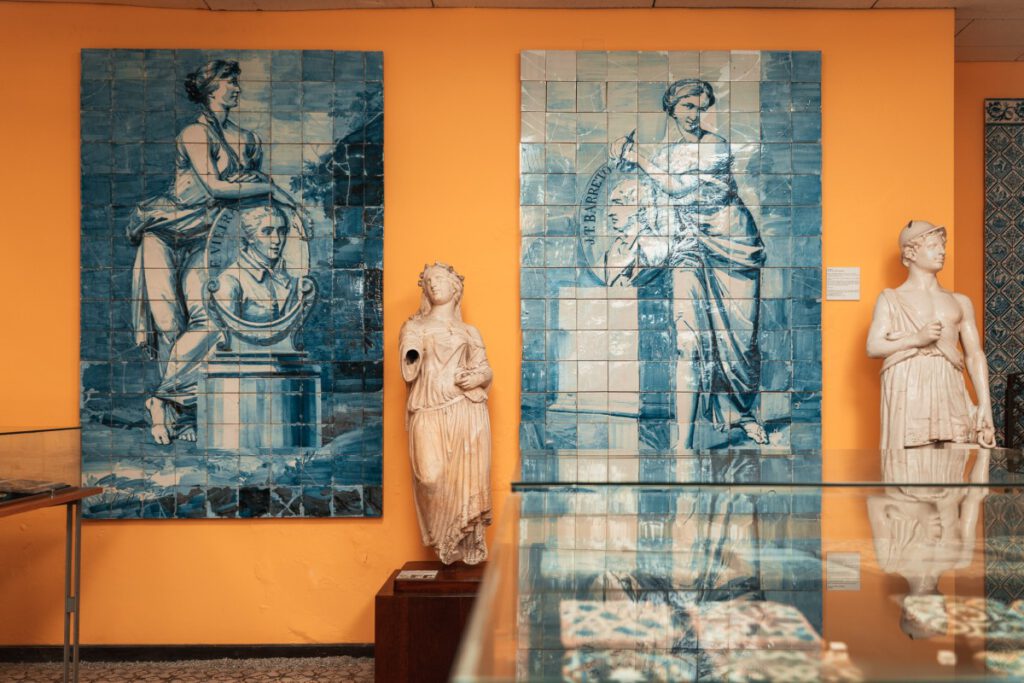
If you like the colorful ceramic tiles of Porto as much as I do, then you should definitely stop by here. Best of all, admission is free.
14. Avenida Dos Aliados
Avenida Dos Aliados is Porto’s largest boulevard. It is lined with magnificent buildings with impressive architecture, most of them banks or hotels. At the end of the street is the town hall, in front of which you can admire a sculpture by the famous Portuguese writer Almeida Garrett.
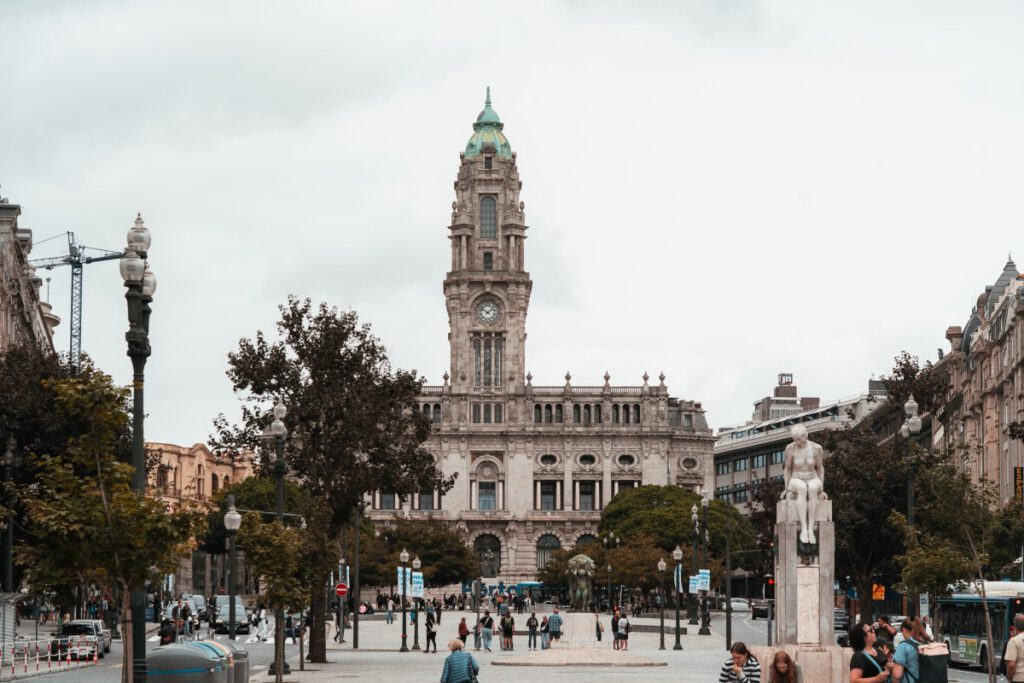
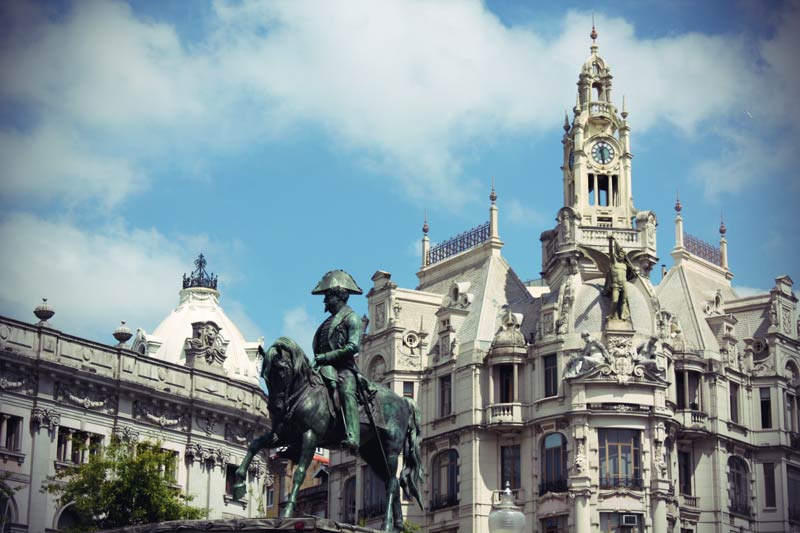
15. Capela das Almas de Santa Catarina
The photogenic Capela das Almas de Santa Catarina, with its impressive exterior façade covered in blue azulejos, is also known as the Chapel of Souls and is arguably Porto’s Instagram hotspot.
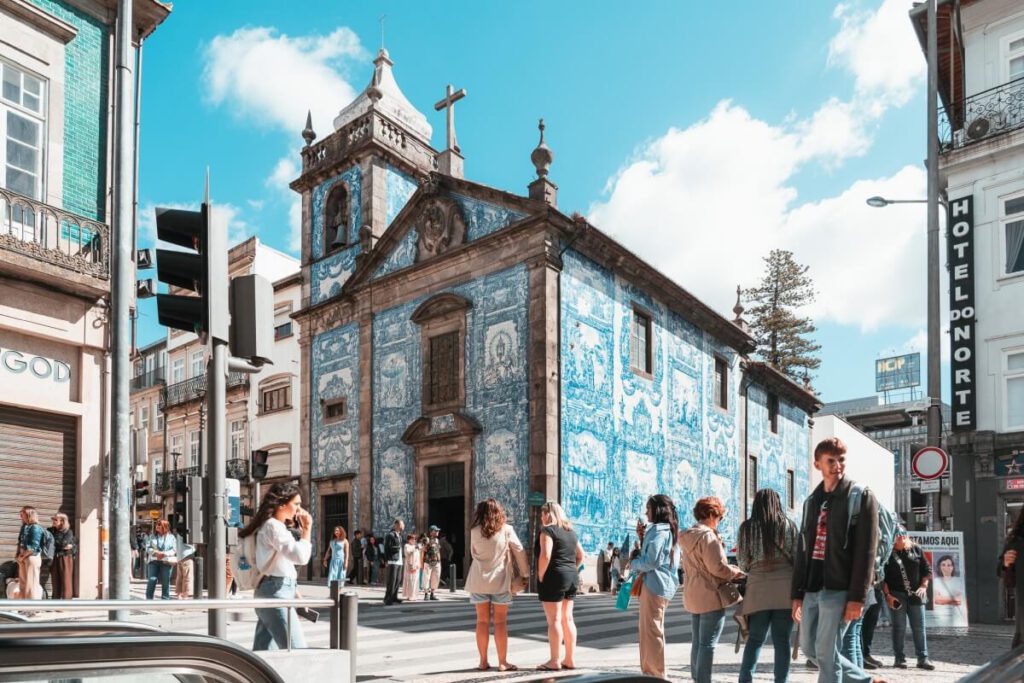
Almost more interesting than the azulejos are the many tourists standing around on the Rua de Santa Catarina street taking photos of their partner or selfies and almost being run over by passing cars. Every now and then there is also a lot of honking.
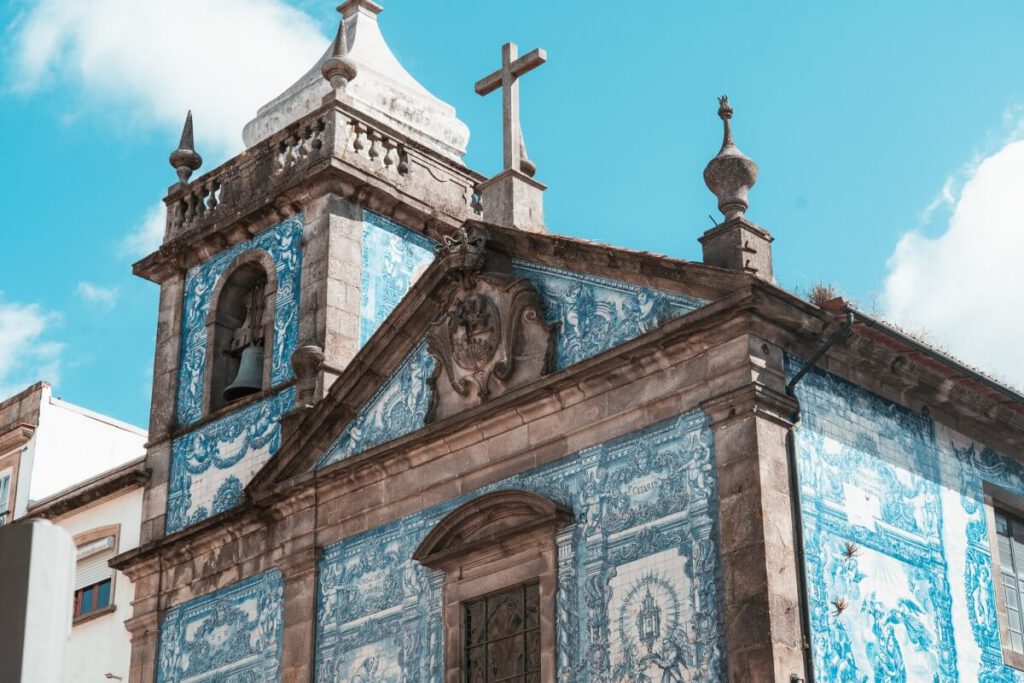
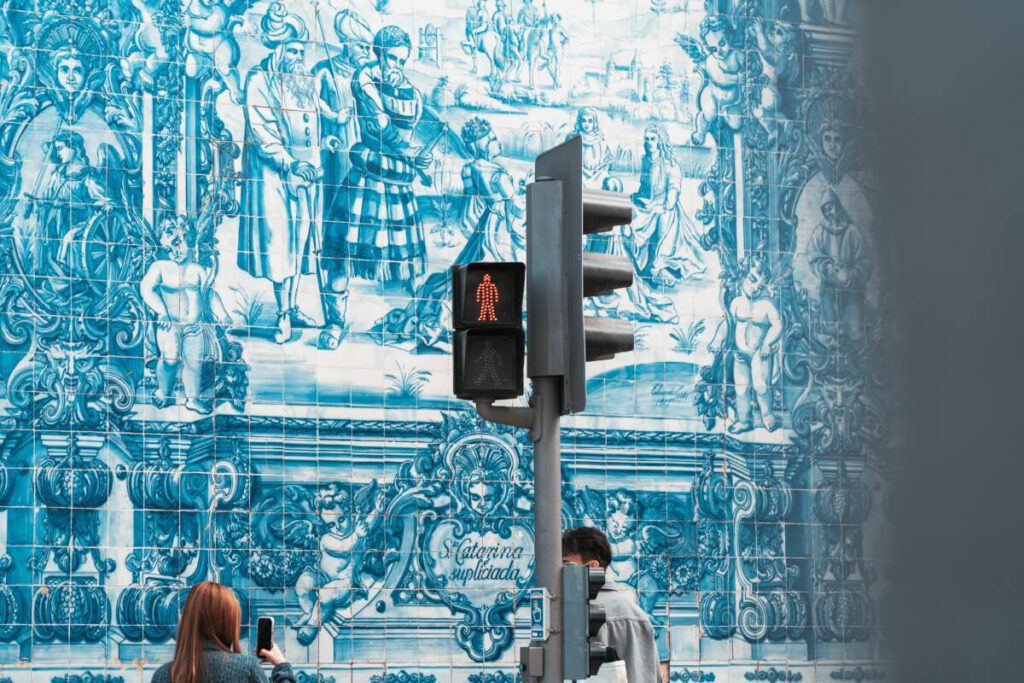
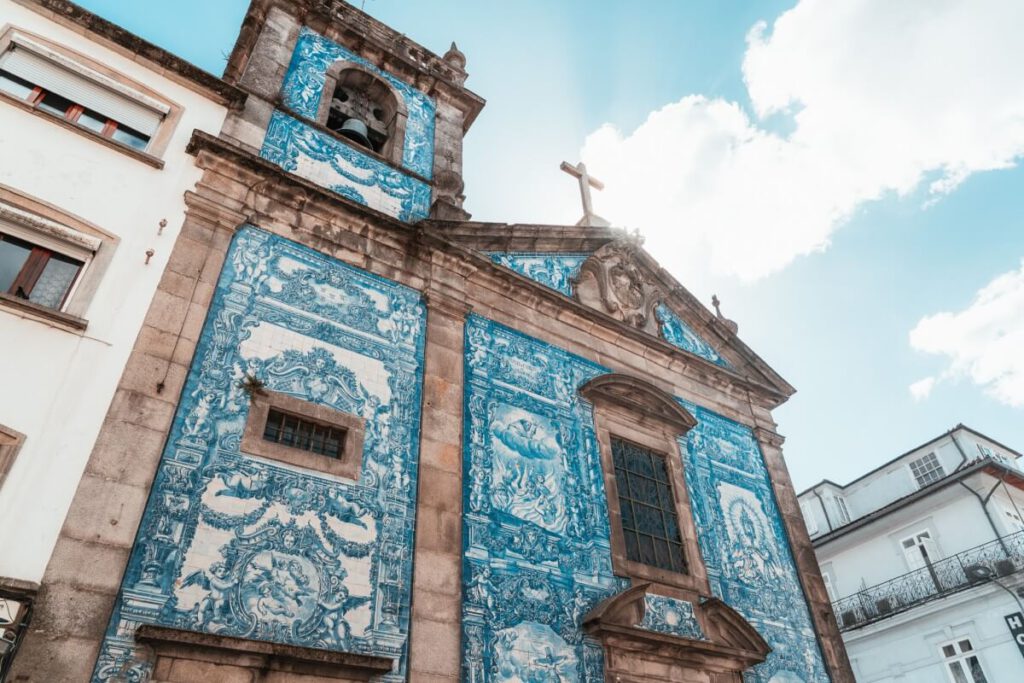
16. Igreja de Santo Ildefonso
The Igreja de Santo Ildefonso, with its 2 striking bell towers flanking the façade, is one of the most beautiful churches in the city.
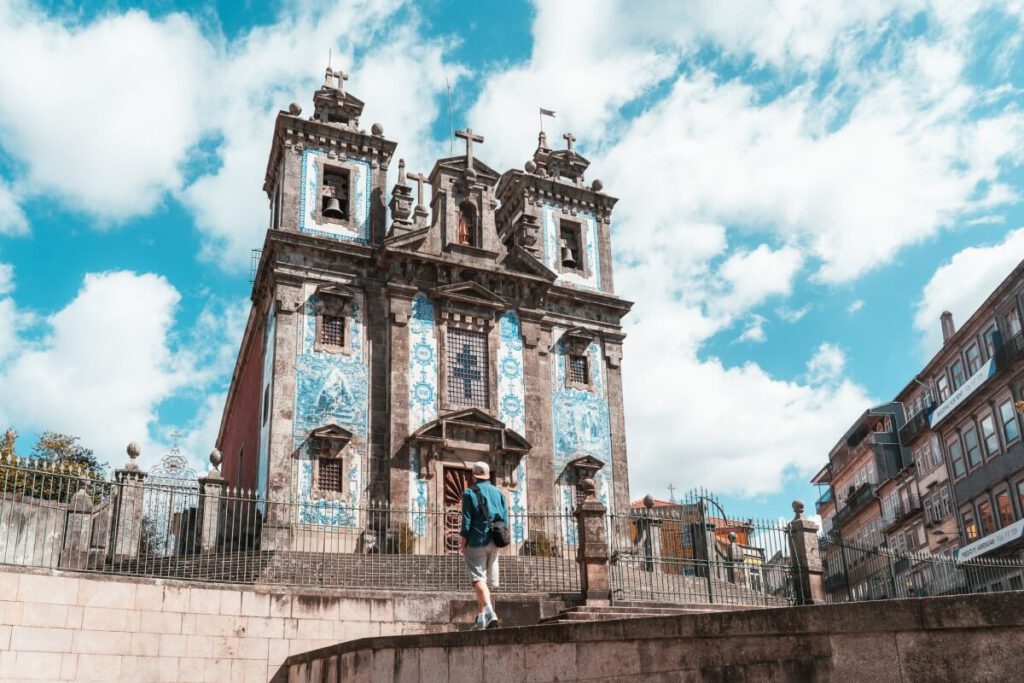
There is also a museum inside, which you can visit for an entrance fee of just one euro.
17. Jardins do Palácio de Cristal do Porto
One of Porto’s most beautiful gardens, the Jardins do Palácio de Cristal do Porto, offers a breathtaking view over the city and the Douro.
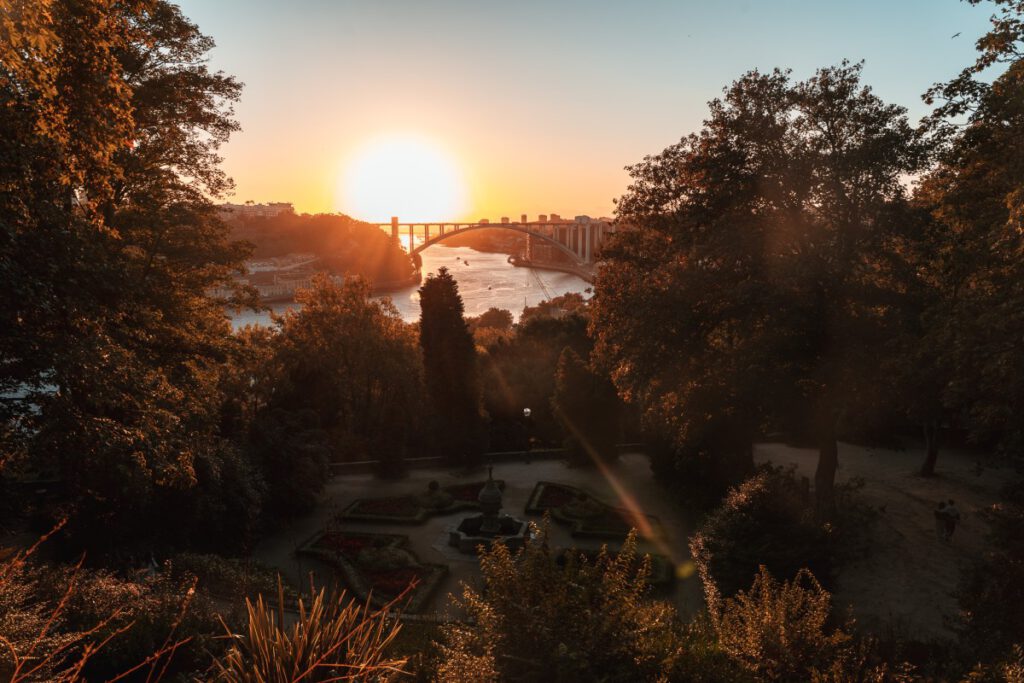
Peacocks roam freely in the park. Fountains and statues are hidden among rhododendrons, camellias, araucarias, ginkgos and beeches. The area around the Miradouro da Ponte da Arrabida is the most beautiful, because from here you have a great view of the Douro, especially at sunset.
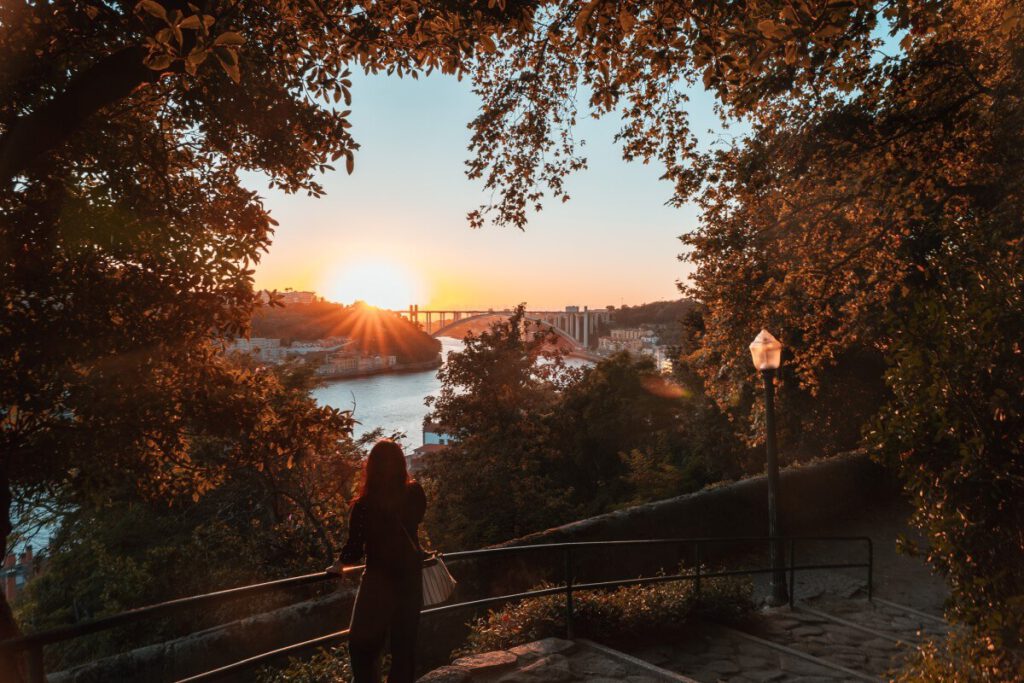
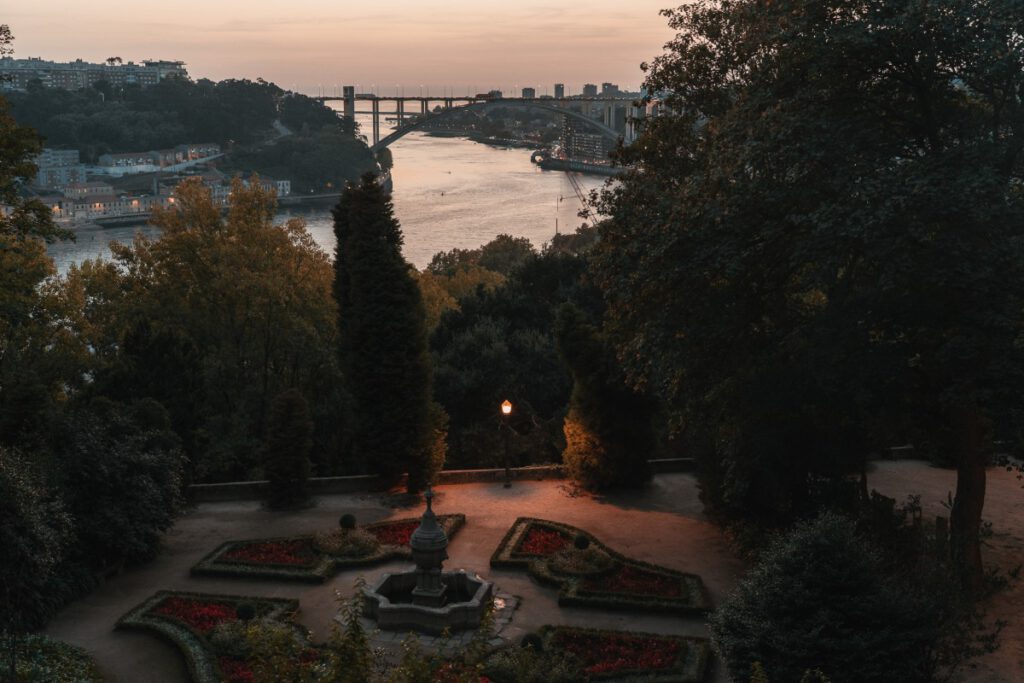
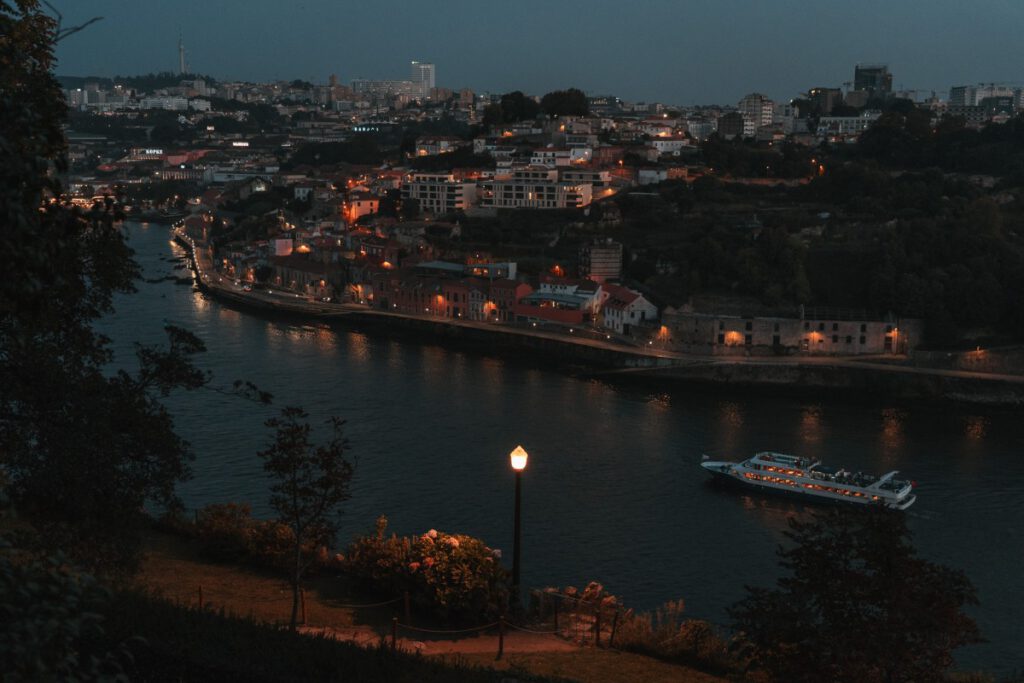
Tip: Pack yourself a wine, some cheese and bread and sit down on one of the stone steps to soak up the evening atmosphere with a view of the Douro.
18. Casa da Musica
The Casa da Musica is a concert hall, but is primarily known to Porto tourists for its special architecture. It has a polygonal shape made of white exposed concrete and looks like a crystal.
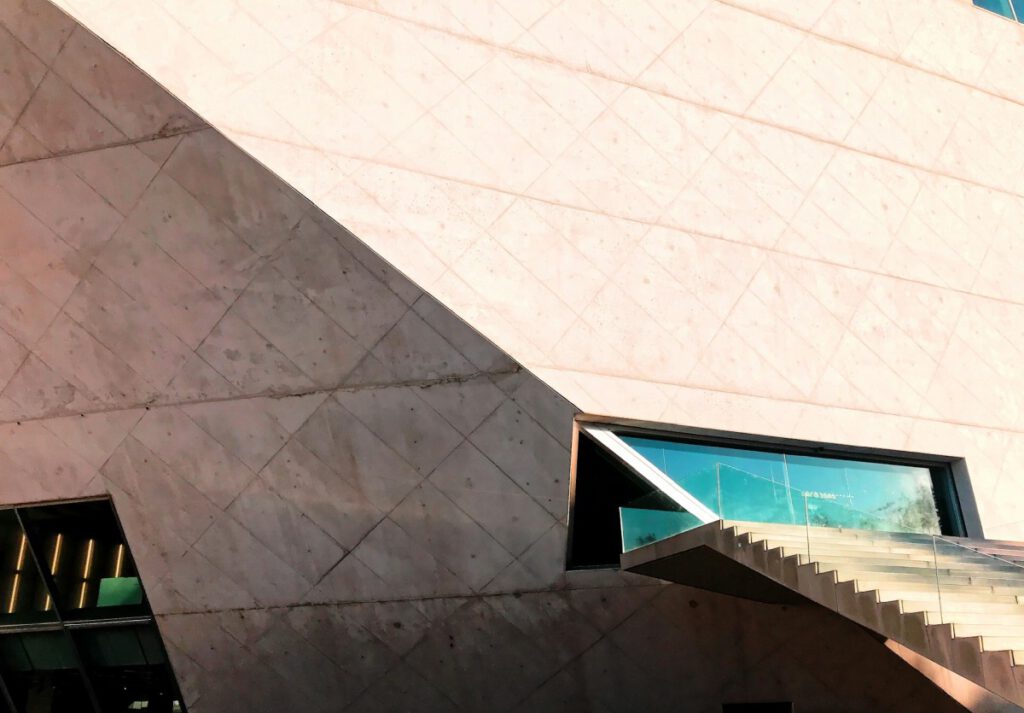
Even if you don’t want to attend a concert, festival or workshop in the Konzerthaus, it’s worth a visit just to see the building. There are 2 different tours you can take here, one with a guide and one without a guide but with an audio guide.
Festa de São João
If you happen to be in Portugal on June 23, you should definitely spend the night in Porto. Every 23 June, Porto is transformed into a colorful sea of flags, garlands and lanterns. This is when the Festa de Sao Joa, Porto’s city festival, takes place.
Everywhere on the street, but especially in the city center, people celebrate parties and play music. There are concerts and competitions, such as running over fire. The atmosphere is cheerful and exuberant, almost crazy.
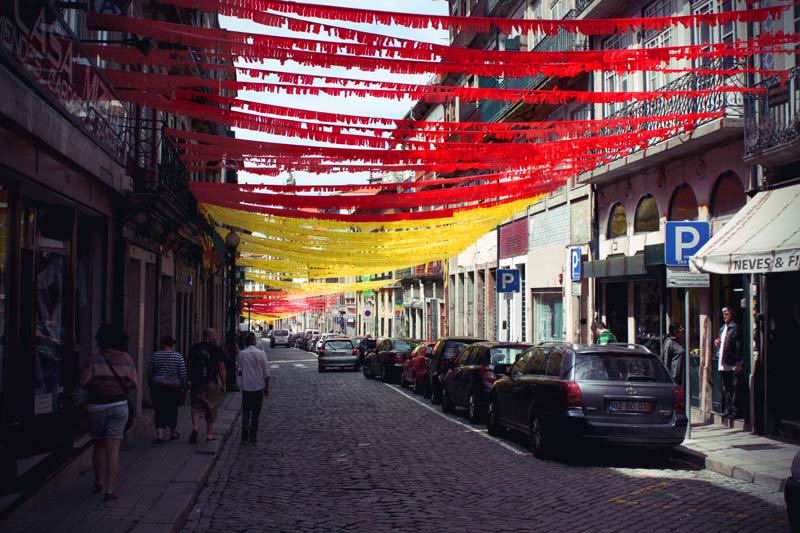
The traditions typical of the festival are also crazy. Everywhere you go, strangers throw garlic cloves or small plastic hammers at you. I still haven’t quite figured out what it’s all about. But it probably has something to do with throwing things at people you love or find attractive. So watch out 😉
Tip: Excursion to the Douro Valley
Once you are in Porto, you should take the opportunity to explore the Douro Valley – one of the most beautiful and traditional wine regions in the world. This region is not only home to the world-famous port wine, but also impresses with its breathtaking, idyllic landscape and romantic atmosphere.
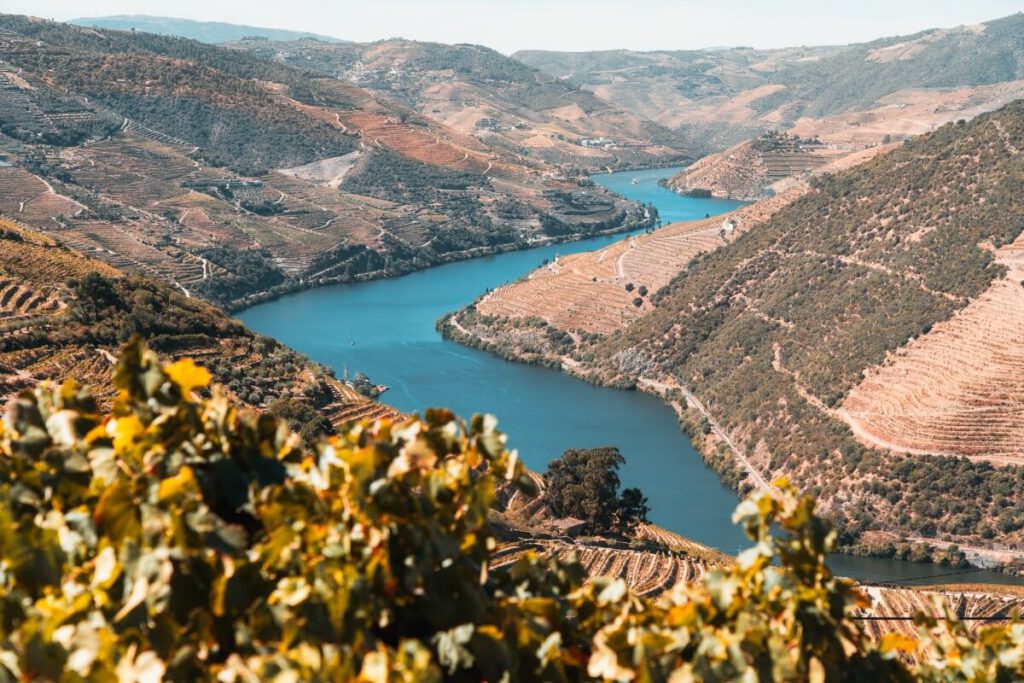
Rolling vineyards, picturesque villages and the meandering Douro River create an unforgettable experience full of nature and culture. There are several tours that offer day trips directly from Porto with return transfers.
Porto insider tips
In addition to the typical Porto sights, there are also a few Porto insider tips that are more likely to be visited by locals or are at least not among the better-known Porto sights. Here is a small selection of my favorites.
The McDonalds on Avenida Dos Aliados
A McDonald’s branch is not necessarily one of the typical attractions you want to see on a city trip. I myself would never voluntarily eat in such a store. But the branch on Avenida Dos Aliados is located in the historic building of the former Café Imperial, a magnificent art deco café from the 1930s. If you leave out all the fast food and just pay attention to the interior and the exterior decoration with the big eagle, then a visit to McDonald’s can be fun.
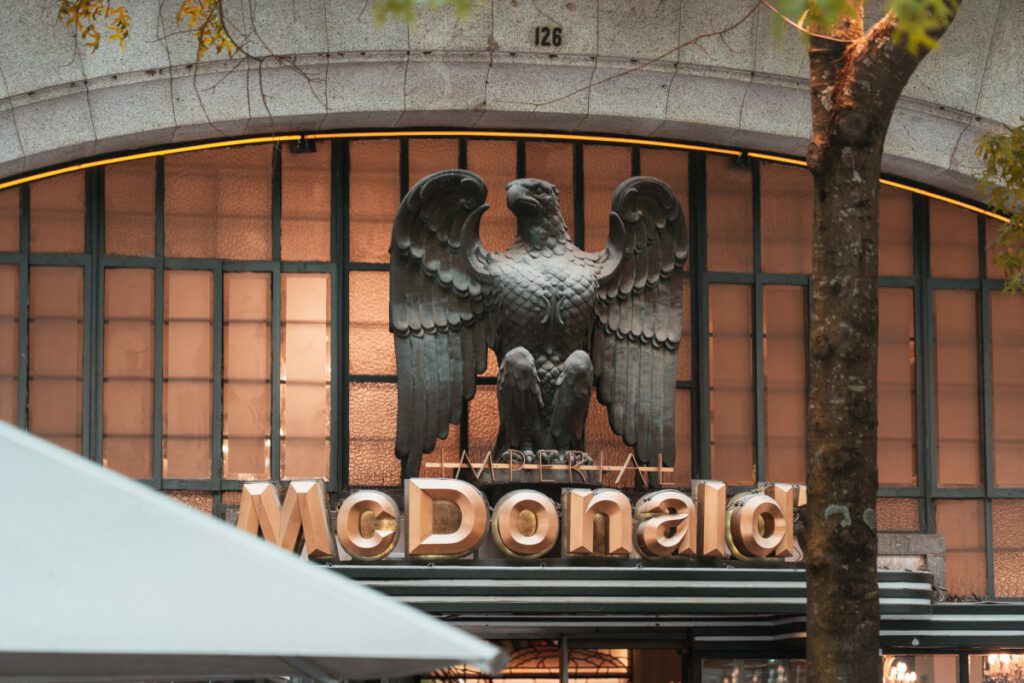
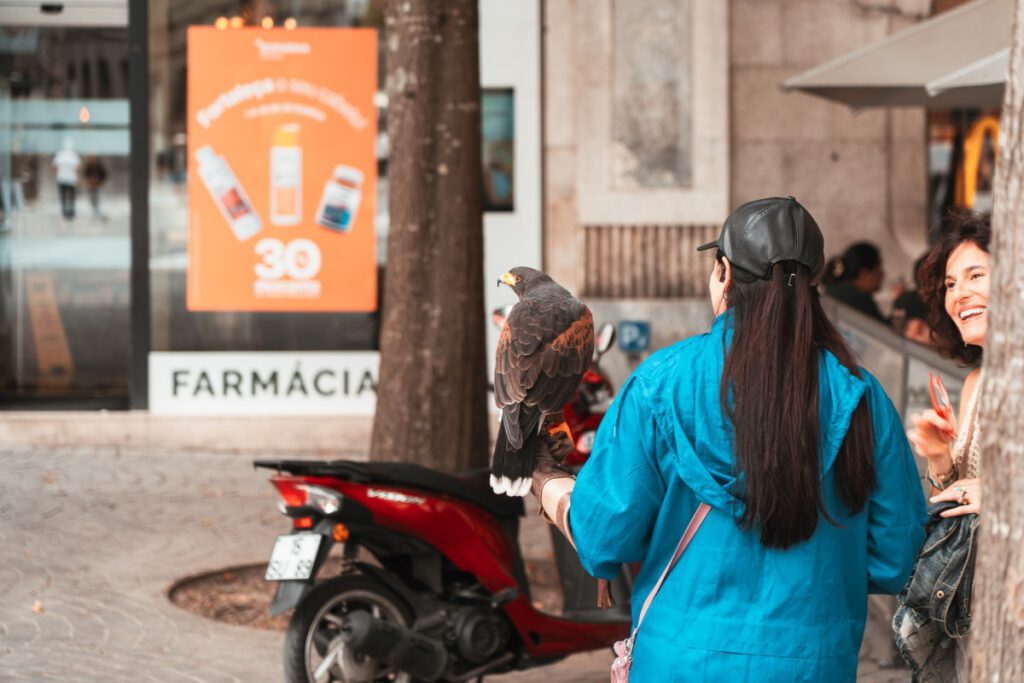
Time Out Market
There is also one of the popular Time Out markets in Lisbon and since 2024 also in Porto, right next to São Bento Central Station. You should stop by here, especially if you’re hungry, as you’ll find 12 cool restaurants and 2 bars in this market. One of the highlights is the Sala de Prova. This is literally the tasting room in the market’s striking tower. There are tastings of Douro and port wine with a view over the rooftops of Porto.
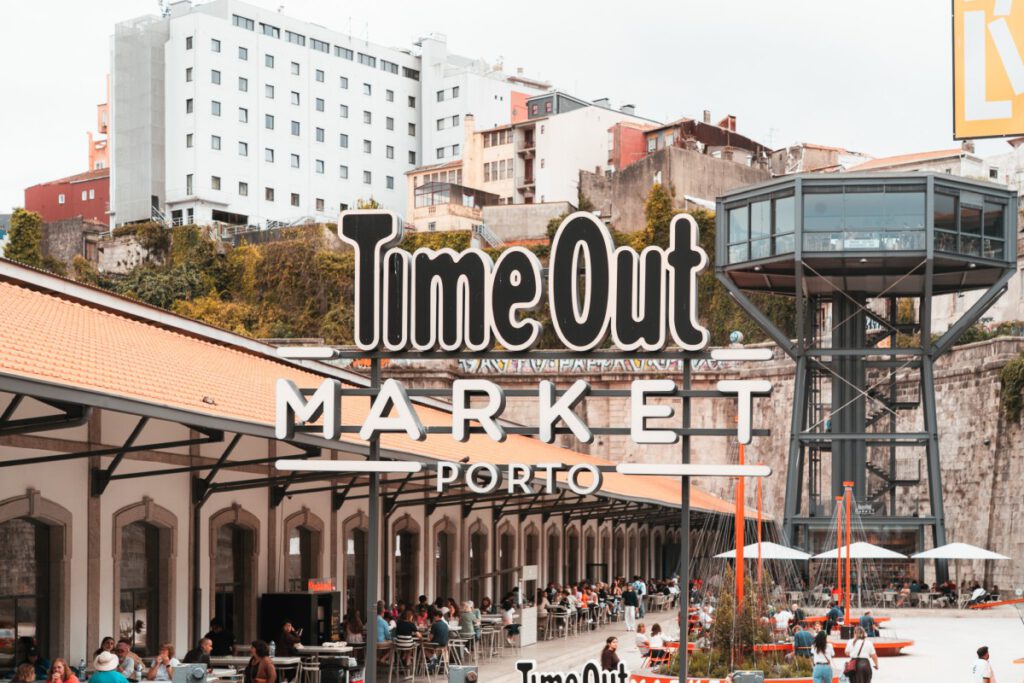
Francesinha at Café Restaurante O Afonso
If you’re in Porto, you should definitely try a francesinha. This is a traditional sandwich invented in Porto. Depending on the recipe, it is actually just a sandwich of toast topped with cheese and ham, sausage, minced meat or steak. However, some restaurants also offer vegetarian versions.
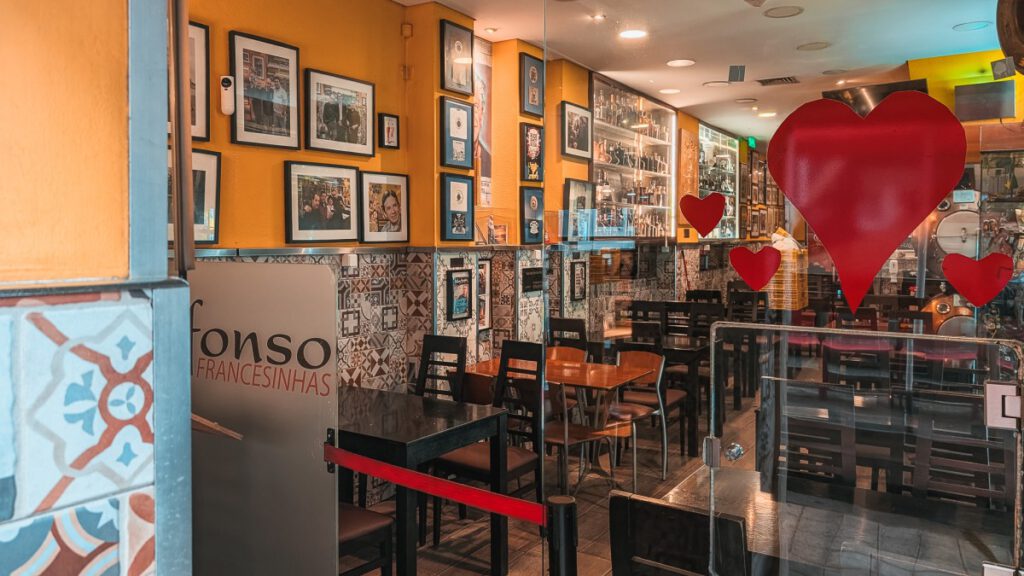
One of the best places for traditional francesinhas is the Café Restaurante O Afonso. It exudes an exciting Formula 1 atmosphere, as it is decorated with some props from Ayrton Senna, a deceased legendary racing driver. French chef Anthony Bourdain has also visited the restaurant. It is not unusual for long queues to form in front of the restaurant.
Sunset at the Miradouro do Passeio das Virtudes
This viewpoint is often a meeting point for young people and also a great spot for watching the sunset. The neighboring bars and restaurants serve wine, beer and tapas.
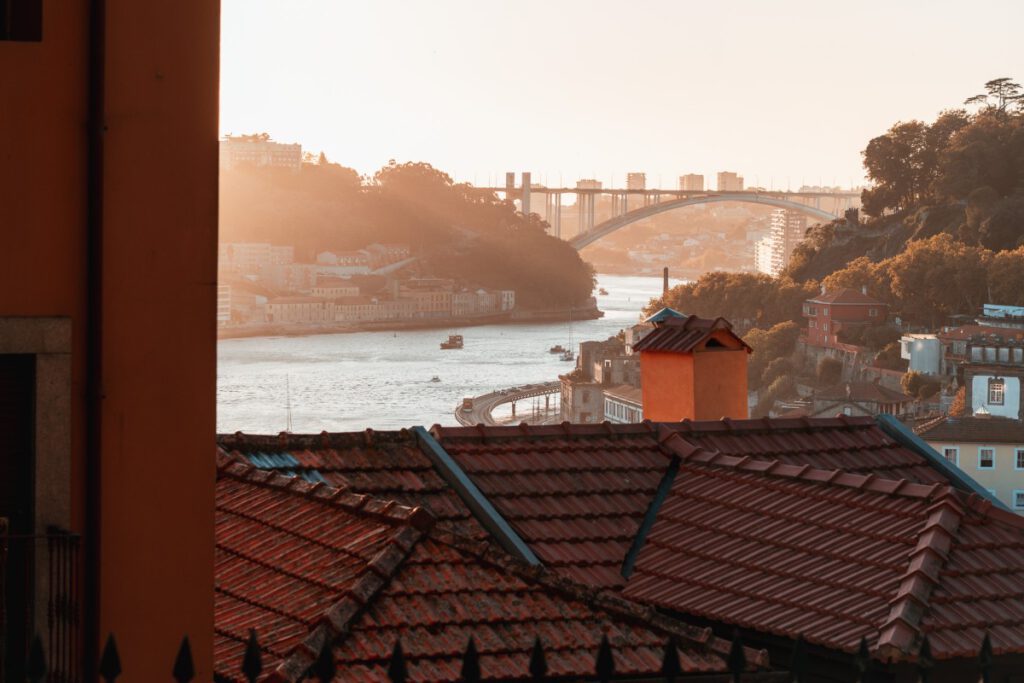
Sunset at the Jardim do Morro
The Jardim do Morro garden is very popular for watching the sunset. Sometimes it gets so crowded here in the evening that you can no longer see the meadows.
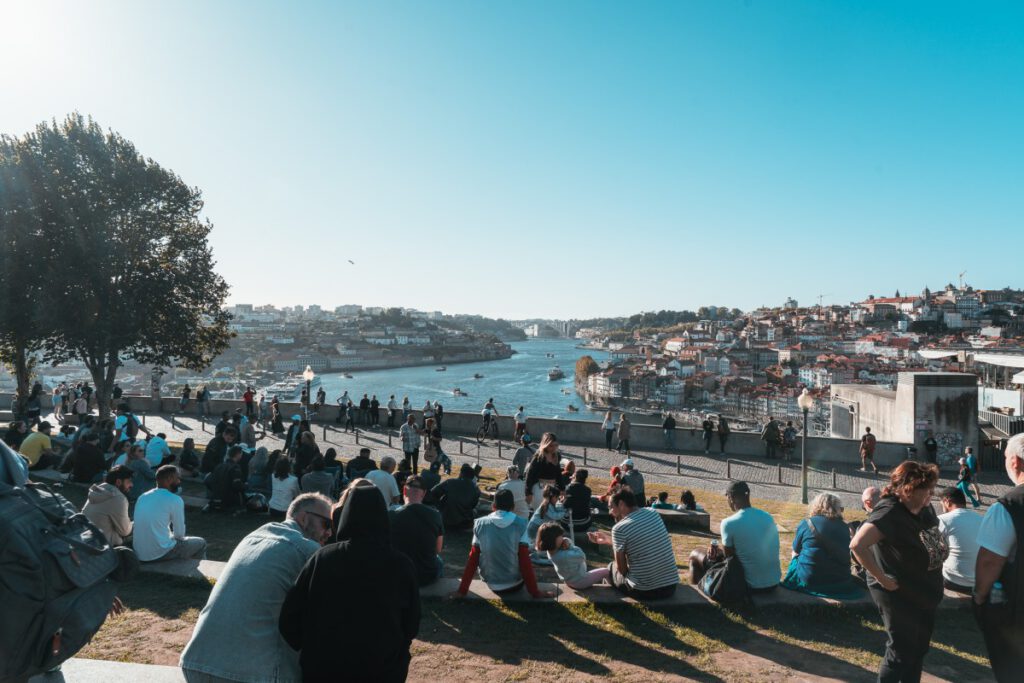
The reason: from here you simply have a brilliant view of the Douro, Porto’s old town and Vila Nova de Gaia.
Sunset at the Parque da Quinta da Macieirinha
This park is a small green area spread over several terraces with the best view of the Douro estuary. It’s my favorite spot for sunset in Porto because you have a perfect unobstructed view from here and it’s not as busy as the Jardin do Morro.
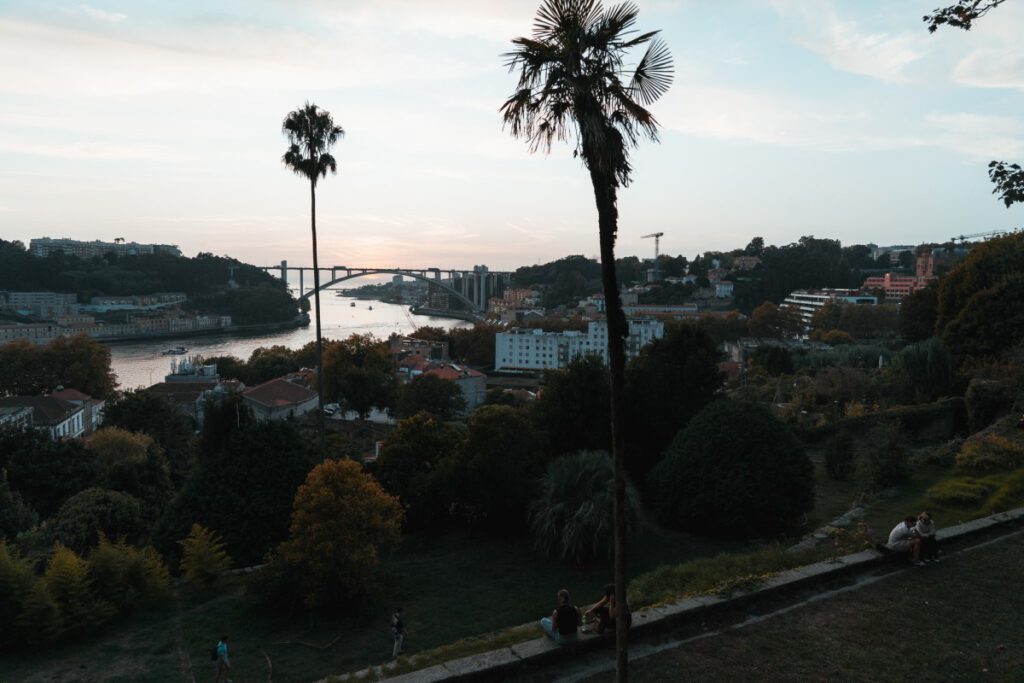
Museu Romântico
Right next to the Parque da Quinta da Macieirinha is this small museum dedicated to the age of Romanticism. It is located in the Quinta da Macieirinha, an old country house. Here you can discover lots of art and furnishings from the Romantic period.
Mercado Bom Sucesso
The Mercado Bom Sucesso in Porto is a modern, lively market with over 40 food and drink stalls. You will find a wide variety of Portuguese and international specialties here.
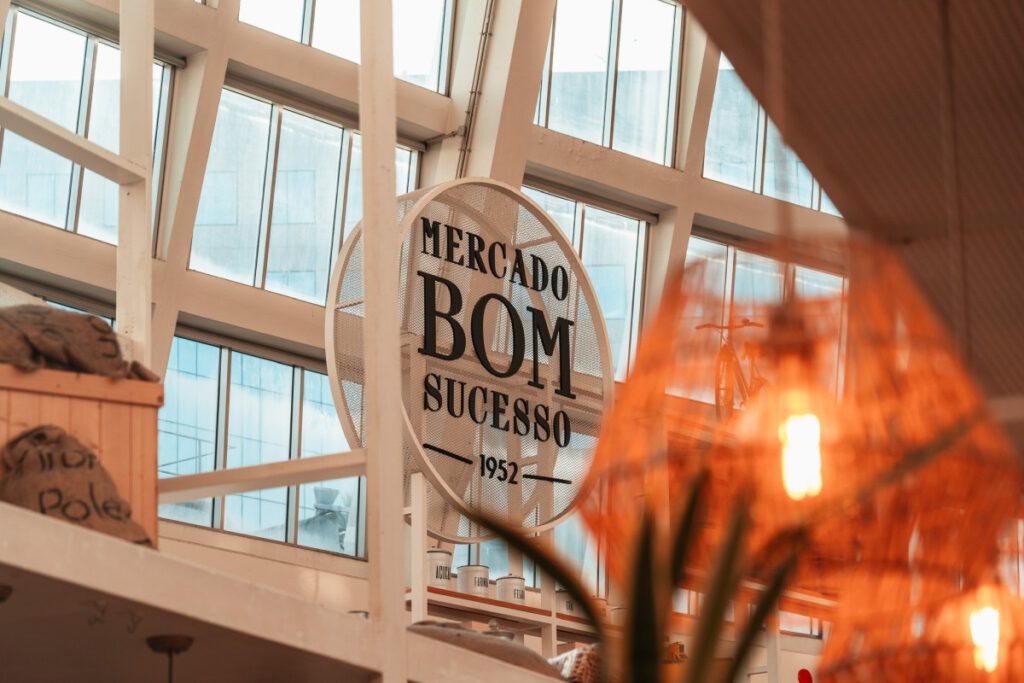
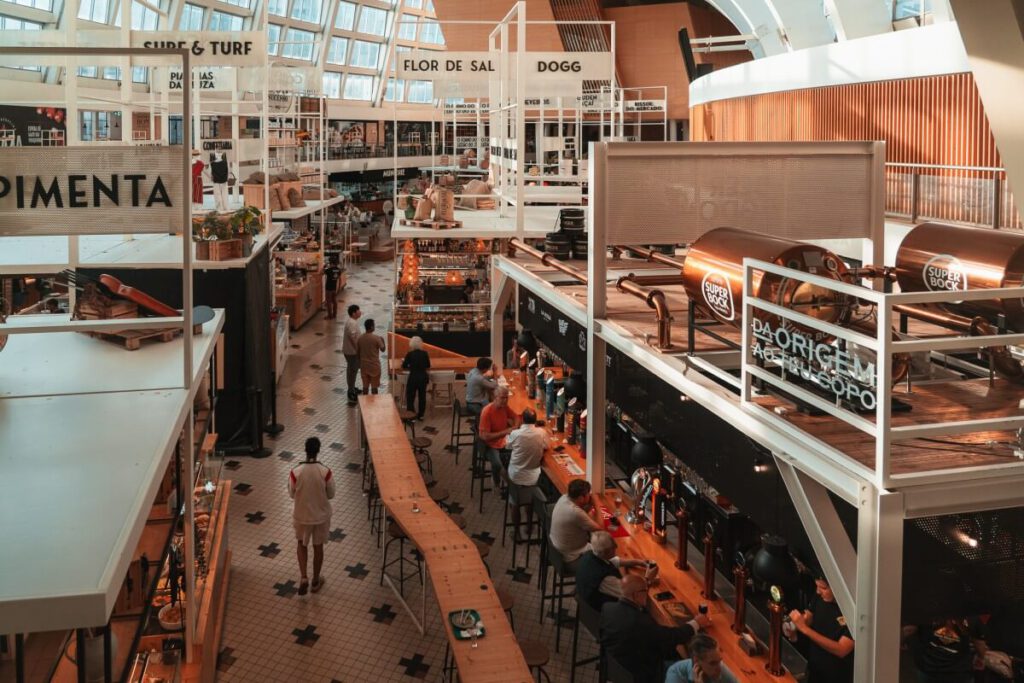
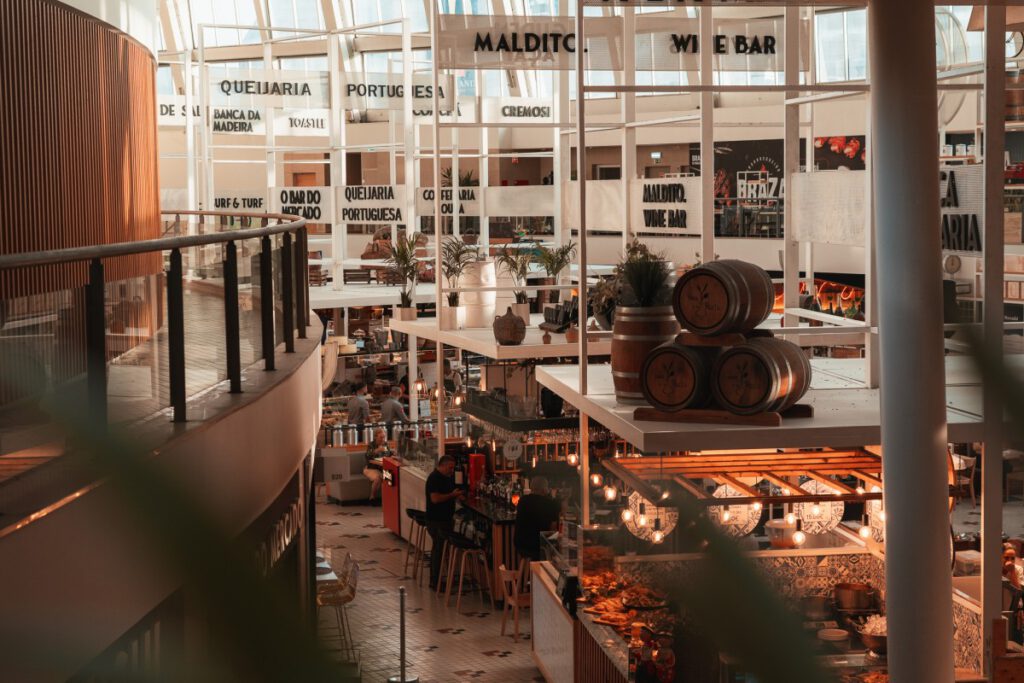
The azulejos at São Bento Central Station
Train stations are functional, usually centrally located places in a city, but rarely a place of interest. Not so in Porto. The reception hall of the main station is an eye-catcher with its azulejo walls and looks a bit like a gallery of paintings. A total of around 20,000 painted tiles adorn the hall. They depict historical and cultural scenes from Portuguese history.
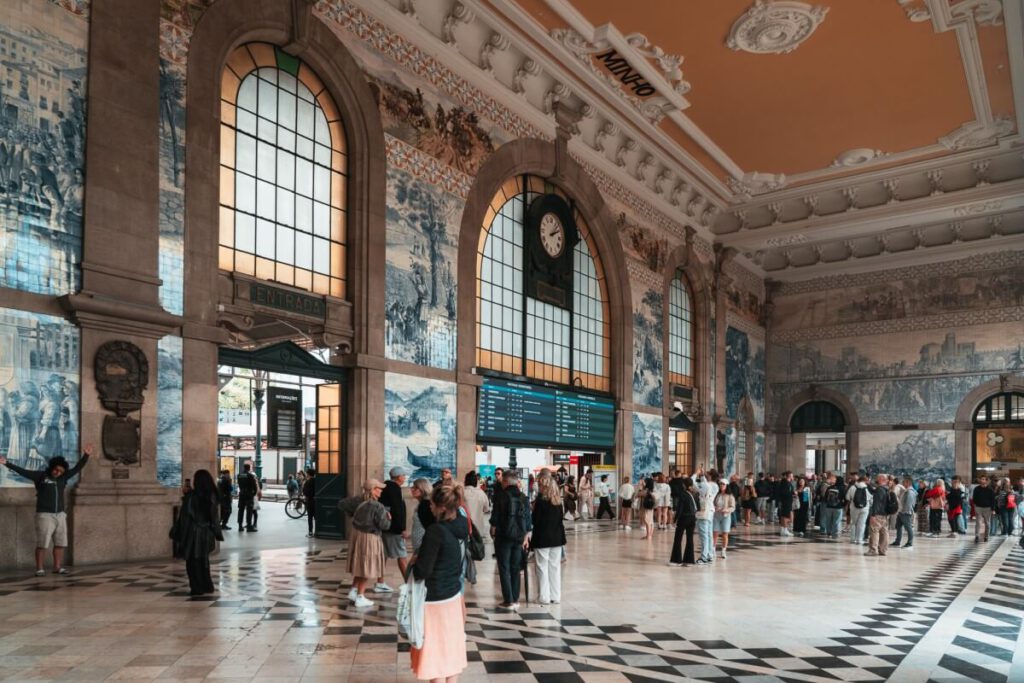
Teatro Nacional São João
The theater of Porto was opened in 1798, but burned down in 1908 and was then rebuilt.
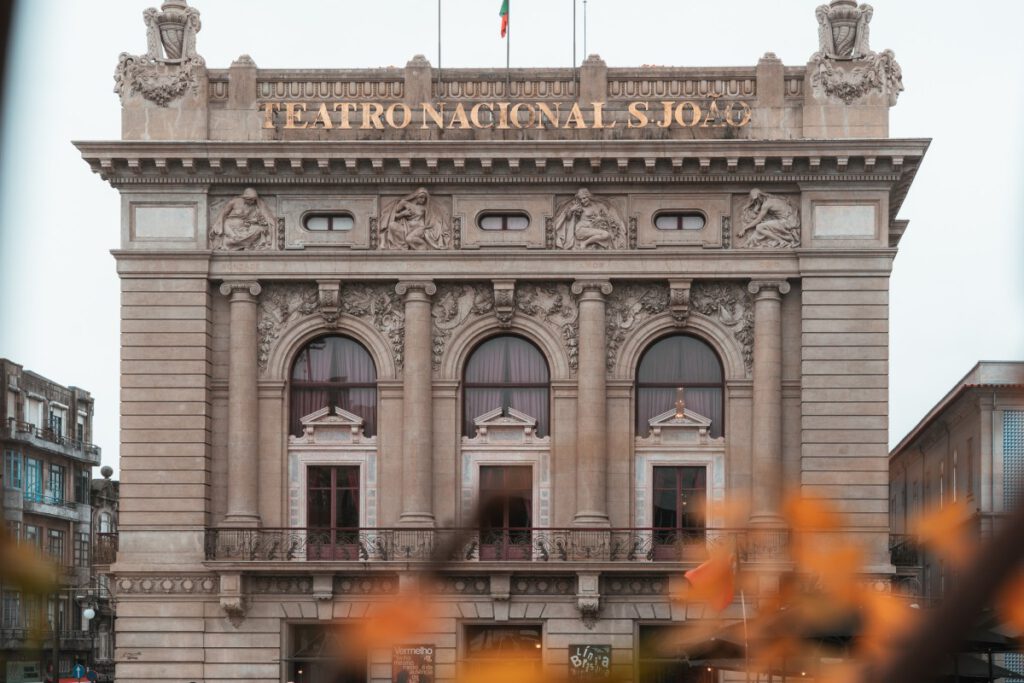
There are only Portuguese performances here. However, you can take part in an English-language guided tour of the theater to learn more about its history. I personally found it very exciting to simply walk around the theater and discover the many faces carved into the exterior façade.
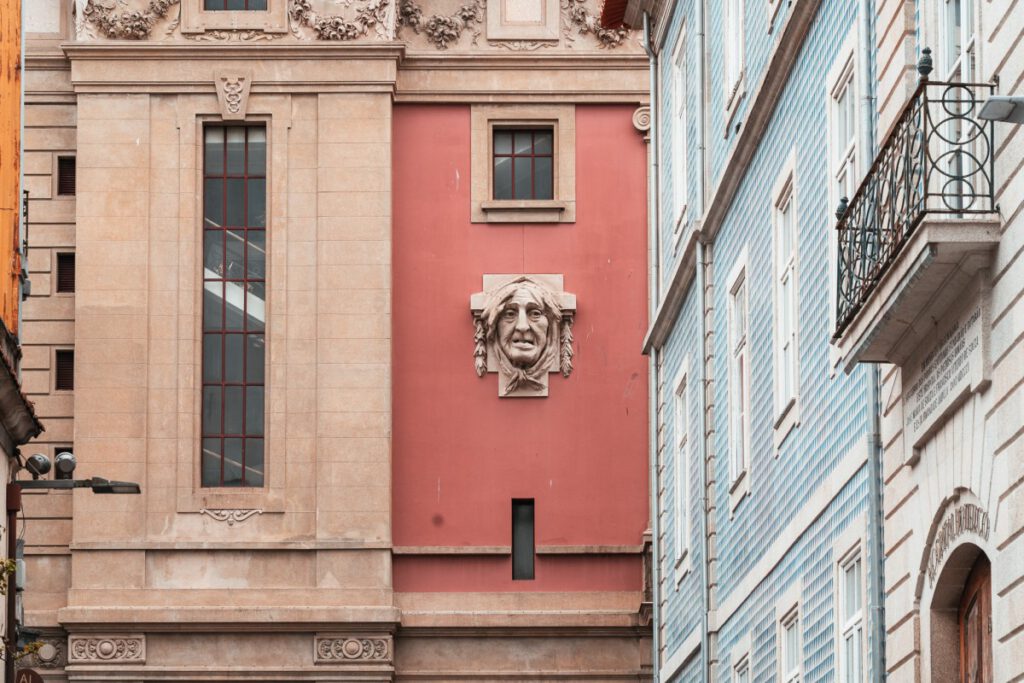
Museu do Carro Eléctrico
If you walk through Porto, it is not unlikely that you will come across one of the historic streetcars. If you want to see more of them, the best place to go is the Porto Tram Museum. This is housed in a historic power station building on the banks of the Douro and displays a unique collection of historic streetcars from different eras.
Street art: Painel de Azulejos
In addition to the historic, often blue azulejos, there are also more modern KEramic tile artworks on the walls in Porto. A very impressive one is the Painel de Azulejos by Joana Vasconcelos. It consists of around 8,000 hand-painted ceramic tiles spread over 20 meters on the façade of the Steak ‘n Shake restaurant.
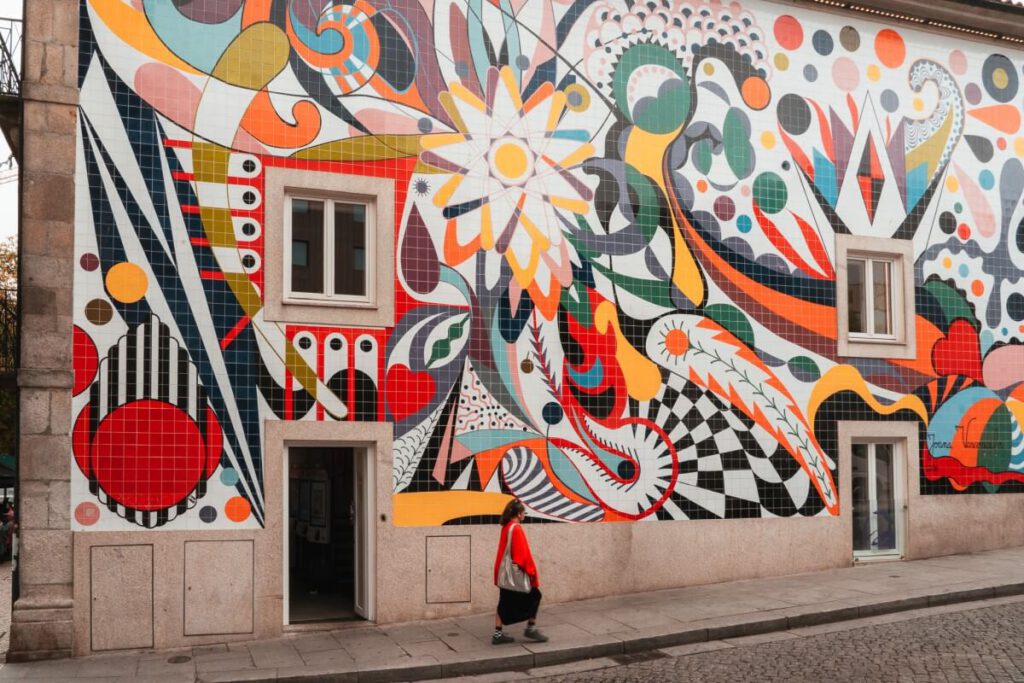
Mercado Ferreira Borges
The Mercado Ferreira Borges is a famous market hall from the 19th century, with an interesting iron and glass construction. Inside there are many stalls where you can buy Portuguese clothes, jewelry or other local products – perfect for souvenirs.
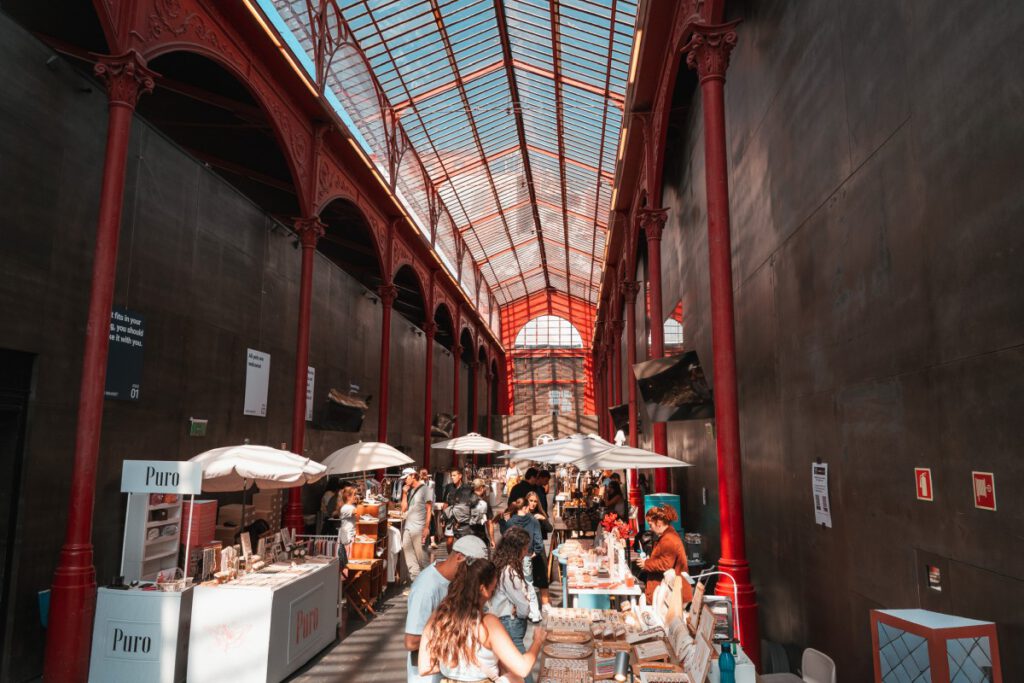
You can also sit on the terrace with a beer or wine and watch the hustle and bustle on the street in front of the Ribeira.
Have you ever been to Porto and do you have any good Porto tips? Then scroll down and leave me a comment.
Tools & services I recommend for your trip:*
📶 Flexible and affordable mobile Internet worldwide
🚁 My drone for aerial photography
🚗 Find and compare cheap rental cars
🎟 Find and book cool activities
🔒 Secure Internet connection with NordVPN
*Note: These links are affiliate links. If you book through them, I will receive a small commission without it being more expensive for you. A purchase from you via these links helps me to continue offering free content without annoying ads on this website. Thank you for your support! I really appreciate it!

